- Skip to main content
Aspen Expeditions

Experience the classic 10th Mountain or Braun Huts located from Aspen to Vail with Aspen Expeditions. Unplug from the rest of the world and connect with family or friends in the beautiful Colorado backcountry. Enjoy day guided ski tours and at night relax in the warm hut with gourmet food.

- Duration 6 Days, 5 Nights
- Backcountry Hut
- Backcountry Skiing

Benedict 100
The Colorado Classic Ski Tour! The Benedict 100 is noted for its endurance and often challenging conditions the Benedict 100 connects Aspen to Vail via the historic Benedict 100 route. This is an extraordinary opportunity…

- Duration 3 days, 2 nights
Women’s Intro to Backcountry Skiing Hut Trip
Join us for our women’s introductory backcountry skiing and splitboarding hut trip! Leave the boys behind for a two night / three day introductory backcountry hut trip with veteran Aspen Expeditions guide Kelli Rohrig and…

Women’s Ski & Splitboard Mountaineering Hut Course
Learn ski & splitboard mountaineering skills with our expert female guide team! With an emphasis on education, our Ski and Splitboard Mountaineering Course is a fantastic introduction for those who are looking to take their…

- Duration Varies
Standard Hut Trip
Aspen is home to two of the best, most extensive backcountry ski hut systems in our country Both the 10th Mountain and Braun Hut Systems can be accessed just a few miles from Aspen, which…

All-Inclusive Braun Hut Trip
The Braun Hut System, just a few miles from Aspen, offers skiers and riders a backcountry escape deep into the heart of the Rocky Mountains Backcountry skiing up to one of the huts, where one…

All-Inclusive 10th Mountain Hut Trip
Spanning from Vail to Aspen, the 10th Mountain Hut System offers skiers and riders an escape deep into the heart of the Rocky Mountains Backcountry skiing up to one of the huts, where one might…
Explore Other Adventures
Check out our winter hut trips in the heart of the San Juan Mountains with San Juan Expeditions.
Visit San Juan Expeditions

Up to 50% off 2024 & past season styles at evo.com!
- The New Class Film Series
- The Grand Traverse
- Backcountry Bound Film Series
- Mountain Skills
- Avalanche Resources
- Uphill Travel Guide
- Ski Mountaineering Skills with Andrew McLean – Season 1
- Ski Mountaineering Skills with Andrew McLean – Season 2
- 2024 Editors’ Choice Splitboard Reviews
- 2024 Editor’s Choice Ski Reviews
- 2024 Editor’s Choice Splitboard Boot Reviews
- 2024 Editor’s Choice Ski Boot Reviews
- 2024 Editors’ Choice Apparel Reviews
- Tried & New
Current Issue
- Back Issues
- Carry Backcountry Magazine in Your Shop
- Get the 2025 Gear Guide
Hut Routes: Six North American Hut-to-Hut Traverses
Hut traverses were born in Europe, where groups like the Swiss Alpine Club began building and managing high-mountain shelters as early as the mid 19 th century. And while North America can’t hold a candle to Europe’s extensive mountain-chalet infrastructure and deep hut heritage, there are more than 200 backcountry huts, lodges and yurts throughout the U.S. and Canada. Link some together, and you’ve got a Euro-style ski-touring experience (schnitzel not included).

Big Sheep Traverse Wallowa Mountains, Ore.
Eastern Oregon’s Wallowa Mountains are known as America’s “Little Switzerland” for their jagged alpine terrain, and Wallowa Alpine Huts manages four shelters throughout the range. The outfit offers a five-day, four-night trip that travels between their Big Sheep Hut (6,400 feet) and McCulley Camp (7,500 feet). Sauna and burn skiing included. Source: $800 per person for four nights (includes guiding, meals, portering and shuttle). wallowahuts.com
Telluride to Ouray Traverse San Juan Mountains, Colo.
The route runs east/west along the San Juan Mountains’ Sneffels Range below notable 13,000-foot peaks like Teakettle Mountain, Last Dollar Mountain and Mears Peak. Linking each hut—Last Dollar, North Pole, Blue Lakes, Ridgway and Burn—covers some 35 miles, and the distance between huts varies between five and nine miles. Source: $30 per night per person, unguided. sanjuanhuts.com
Teton Wilderness Hut to Hut Teton Mountains, Wyo.
Out of Jackson Hole, Teton Backcountry Guides operates Wyoming’s sole backcountry hut system and manages three wintertime yurts (plus a summer-only yurt) in the Tetons. Their five-day, four-night hut-to-hut trip stretches between Baldy Knoll Hut (8,800 feet) and Plummer Canyon Hut (8,400 feet) at the southern end of the Tetons. Source: $1,475 per person for four nights (includes meals, porters, guiding and shuttle). tetonbackcountryguides.com
Wapta Traverse Canadian Rockies, Alberta/B.C.
The 28-mile trek across Banff and Yoho National Parks’ Wapta and Waputik Icefields is North America’s premiere hut-to-hut route, linking four Alpine Club of Canada huts (Peyto, Bow, Balfour and Scott Duncan). “North America’s Haute Route,” as it’s often called, takes four to six days, tops out at more than 10,000 feet on Mt. Balfour and can be skied either guided or unguided. Source: Several outfits offer guided trips starting around $1,200 (including meals, guiding and lodging). alpineclubofcanada.ca
Sun Valley Linkup Smoky Mountains or Sawtooth Mountains, Idaho
Sun Valley Trekking has been guiding throughout central Idaho for more than three decades, and several of their six huts lie close enough together to travel between. In the Smoky Mountains, connect Tornak Hut to the brand-new Coyote Yurts for a wildfire-burned glade tour. Northward, in the Sawtooth Mountains, Bench Hut and Fishhook Yurt are easy to link up with a descent of the notable Gun Barrel Couloir. Spend two nights at each shelter. Source: Guided rates are based on number of days and group size. Self-guided options are available, too. svtrek.com
Eklutna Traverse Chugach Mountains, Alaska
Connecting Anchorage to Girdwood, the 38-mile Eklutna Traverse is Alaska’s premiere hut-to-hut route, usually done over five or six days. Shelters along the way include Pichler’s Perch, Rosie’s Roost and Hans’s Hut, each built in the ’60s and managed by the Mountaineering Club of Alaska. The route primarily covers low-angle glaciers, but tops out with a 40-degree descent of Raven Headwall on the final day. Source: Guided rates are based on number of days and group size ($200 per person per day with a group of four). stockalpine.com .
This story first appeared in the February 2014 issue of Backcountry Magazine.
Related posts:
You have listed $800 for the wallowa huts, but the website doesn’t seem to have that number
Ur right thats the old price redeemable if u book before Sept 1 Otherwise $1200 Sorry for confusion
[…] think of the Alps but right here in North America we have a number of killer hut-to-hut traverses. Backcountry Magazine brings us a look at six of […]
[…] your pick of Idaho’s stunning Smoky Mountains or Sawtooth Mountains and head out on the Sun Valley Linkup, a trek that connects a variety of huts depending on your chosen location and the time of year. In […]
Speak Your Mind Cancel reply

Listen to the Backcountry Podcast

DOUG STOUP: THE ICEMAN From playing NCAA soccer to a successful modeling and acting career to being the top polar explorer of his time, Doug Stoup is an enigma. Host Adam Howard recently journeyed to Antarctica with Stoup and their conversation ranges from Doug’s personal training of A-list Hollywood actors to near death experiences; adventures with Doug Coombs; and taking novice skiers to the South Pole. Listen Now »

TELE MIKE RUSSELL: TURNS FOR ALL Tele Mike Russell grew up as a sharecropper’s son in Delaware before attending college and becoming an executive in the pharmaceutical industry. Then he watched the second plane hit the World Trade Center and decided he’d better follow another path, this one to skiing in Colorado, where he’d go on to find a family in the National Brotherhood of Skiers and help found its backcountry program. Listen Now »

ERIC BLEHM: MEET YOUR HEROES Eric Blehm’s roots in snowboarding run deep. He started riding during the sport’s infancy, and after college became an editor at Transworld SNOWboarding Magazine. Years later, he was in a lift line when a fellow rider saw the “Craig Kelly is my Co-Pilot” sticker on his board, and asked Blehm: “Who is Craig Kelly?” He was floored by the notion that there were snowboarders out there who didn’t know who Craig was. And this inspired him to write The Darkest White. Listen Now »
Get your 2024 Gear Guide
Subscribe to the backcountry newsletter, uphill travel.

We’ve compiled a database of U.S. resorts with a little about each individual policy—where and when skinning is allowed, whether or not it’s free during operating hours and the link directly to the resort’s guidelines.
View our resort skinning policies guide »
Gear Reviews
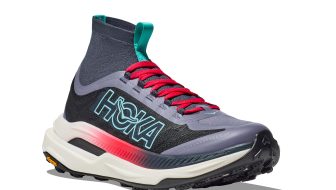
Summer Gear Roundup: Trail Running
Sometimes snowmelt and warmer weather can be a welcome relief. A chance to expand our horizons and chase other … [Read More...]
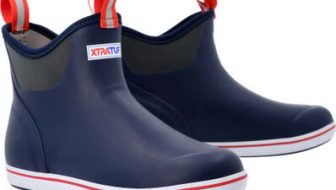
Après Shoes
While ski and snowboard boots are our bread and butter, we all have to get to the trailhead, ski hill or bar … [Read More...]
- Submission Guidelines
- Subscribe to Backcountry

© 2024 Backcountry Magazine 60 Main Street P.O. Box 190 Jeffersonville, VT 05464 802.644.6606

Welcome to the 10th Mountain Division Huts
10th Mountain is a 501(c)3 not-for-profit organization that manages a system of 38 backcountry huts in the Colorado Rocky Mountains, connected by 350 miles of suggested routes. We provide a unique opportunity for backcountry skiing, mountain biking, or hiking while staying in secure, comfortable shelter.
Our name honors the men of 10th Mountain Division of the U.S. Army, who trained during World War II at Camp Hale in central Colorado. Hut visitors share the special spirit of these individuals, especially their pursuit of excellence, self reliance, and love of the outdoors.
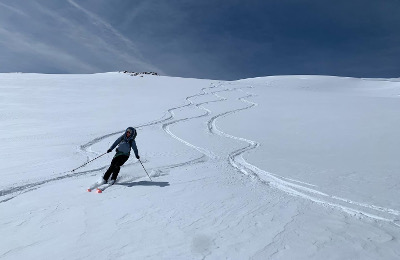
Situated among some of the tallest peaks in the lower 48 and nestled in awe-inspiring meadows, valleys, and forests, the 10th Mountain Division huts are gatekeepers for unrivaled year-round recreation. Winter skiers, snowboarders, and snowshoers will discover limitless playgrounds out the front door. Summertime visitors can bike, hike, climb, and romp from sun up to sun down. Explore the Huts
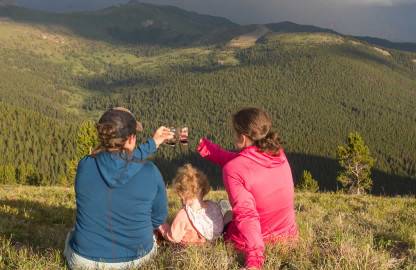
Deep in the remote alpine, connections are made. Absent the distractions of modern living, groups of people discover a renewed love for one another and the world around them when they gather around our huts’ massive dining room tables or watch the sun slip behind the horizon at dusk. Our huts also encourage an immersion in nature, which fosters a crucial connection to the environment, helps develop strong ethics and self-reliance, and creates stewards of public lands.
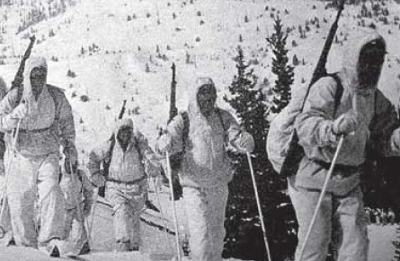
The famed 10th Mountain Division of the United States Army trained during World War II at Camp Hale, Colorado, to prepare for Europe’s challenging terrain. Upon his return from war, Fritz Benedict, a WWII 10th Mountain soldier, envisioned building a system of connected huts similar to those in the Alps and in 1982 the 10th Mountain Division Hut Association formed in honor of the 10th Mountain soldiers and their pursuit of excellence, self-reliance, and love of the outdoors.
Become a 10th Mountain Member
10th Mountain relies heavily upon donations to construct, maintain, and operate the hut system. These contributions also allow us to keep the hut fees affordable. As a member of the 10th Mountain Division Hut Association you will receive a regularly published newsletter, a gift, and the opportunity to reserve huts early for the winter season by participating in our reservations lottery.
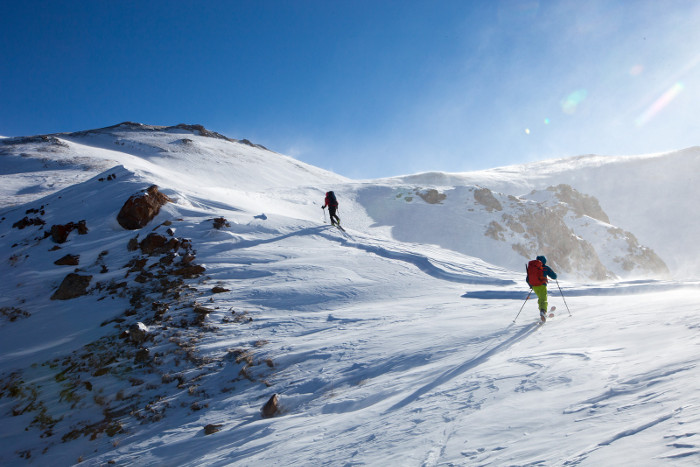
Our Mission
The purpose of the 10th Mountain Division Hut Association is to plan, finance, build and manage, for public use, a mountain hut system that promotes understanding and appreciation of the natural environment while developing individual self-reliance.
Hut Comparison
* Based on most popular route ** Summer only *** Winter only † Applies to the hut structure, not to route considerations
Compare Huts
Select up to four huts to compare.
How to Plan a Backcountry Hut Ski Trip
Ski-in ski-out backcountry skiing? Yes, please. Not much compares to waking up in a toasty yurt next to a wood stove and sipping pre-dawn coffee in the middle of the wilderness. Hut trips are a great way to fully immerse yourself in the world of backcountry skiing because they allows you to spend a few nights off the grid with your friends and explore new zones that are out of reach on a day tour.
There are tons of huts and yurts all over the country, including Colorado , Idaho, Montana, Wyoming, Oregon, and Washington , so choose a zone and get planning!

Safety First
Before you head into the backcountry, be sure you have the proper training , gear , and understanding of the conditions and terrain you plan to enter. Always head into the backcountry with experienced partners you trust.
Planning Your Hut Trip
Unless you get a last-minute invite or score a cancellation, organizing a hut or yurt trip takes some planning in advance. Some hut systems have a scheduled date that reservations open, while others operate on a lottery basis. Mark your calendar with the date that you can start applying for the respective zones you’re looking to ski. For instance, Colorado’s Tenth Mountain Division Huts open up their lottery each February for the following winter, while the yurts managed by Sun Valley Trekking operate on a rolling reservation basis.
You’ll almost always have to book the entire hut. Capacity usually ranges from 6-16 people, so coordinate with your touring partners when booking the hut to make sure you’ve got friends to fill it and help with the cost.
Plan Your Route with onX Backcountry
With your hut confirmation in-hand, it’s time to start planning your route with onX Backcountry. Use the search bar to easily find the hut you’ve reserved to start your e-scouting . Investigate the route to your destination, evaluate slope angle , mark avalanche zones with Waypoints, and denote other considerations for your journey. Calculate your anticipated mileage, elevation profile, and estimate the time it will take you to arrive. These are all great elements of a safety plan . Download a map of your area for offline use and track your progress while on route.
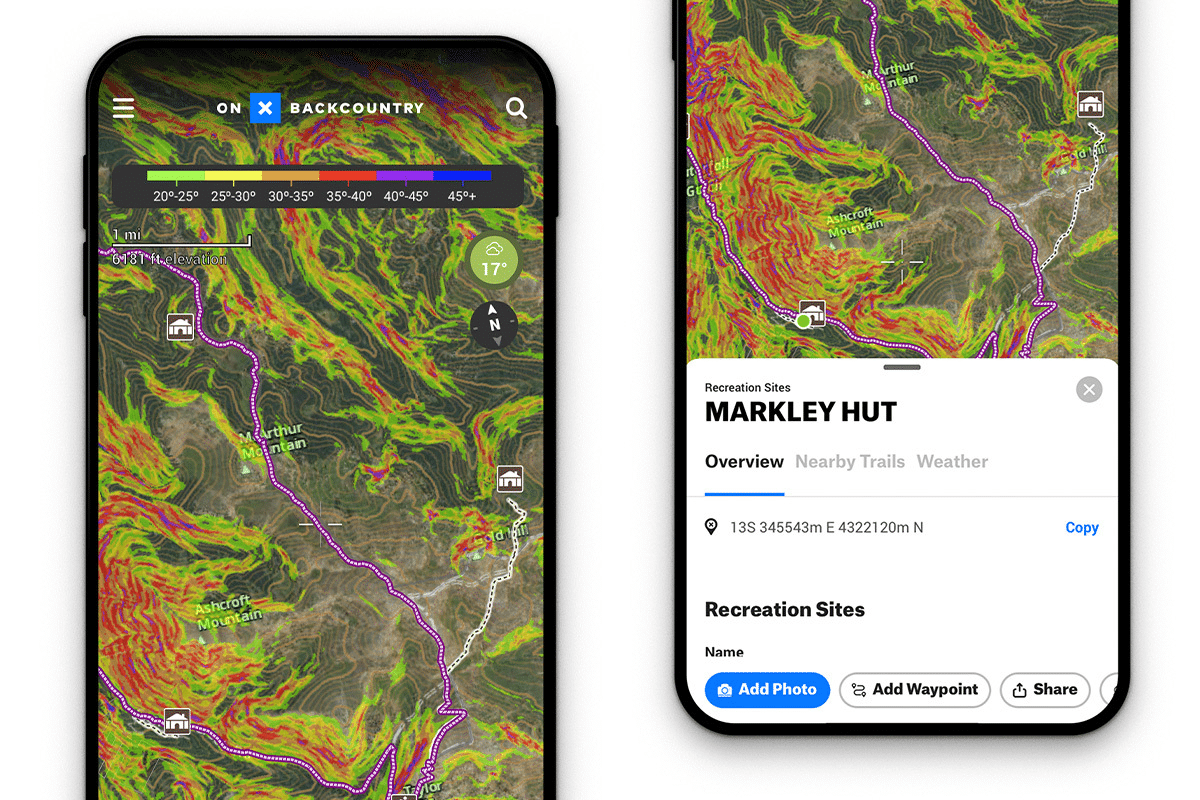
Pack Your Gear
Along with the standard backcountry ski essentials , you’ll need to pack in some extra hut supplies for your stay. A sleeping bag, extra food, pillow, hut slippers, toiletries, and a change of clothes usually require a larger 50 to 70-liter touring pack. If you’ve got a very flat approach that’s mostly on a snowmobile road, some opt to tow a sled, but think twice before towing a sled through steep, undulating terrain. Most huts have mattresses already, but confirm before you head out.
Extra hut gear:
- Sleeping bag : a 20-degree bag is almost always sufficient.
- Hut slippers : Down booties or Crocs are great to wear around when you peel your boots off.
- Extra hut clothes : A t-shirt, sweatpants, or extra set of baselayers that you can wear as pajamas, or use the following day so you don’t have to wear your sweaty layers after skiing. A dry pair of socks goes a long way!
- Toiletries: toothbrush, toothpaste, and any medications you need.
- Extra batteries or chargers : a power box or charger to keep your phone juiced up so you can navigate with the onX Backcountry app.
Coordinating food takes some logistical planning, and everyone does it a little differently. Assigning a few people one communal breakfast or dinner to be in charge of is a great way to divvy up responsibilities. Instead of carrying in your own food for four days, you only have to plan on feeding everyone dinner one night. Since you’ll be out skiing most of the day, it’s often easiest to suggest everyone do their own thing for lunch.
You can rely on a kitchen with a stove and appliances, but look into the specific hut you’re staying at for a full list of amenities before you plan your meals. Huts are often locked so a passersby doesn’t wander in, so be sure you have the check-in instructions (usually a key code) as a note in a Waypoint or written down before you leave the trailhead.

Checking Out
On your last morning, be sure to leave yourself adequate time to follow your hut’s cleaning procedures. With a big group, you can usually get everything done in an hour or so, depending on the hut-specific requirements. Many huts ask guests to chop wood, sweep the floors, and scrub the communal kitchen supplies. Essentially, you want to leave the hut exactly as you found it.
While you can burn some food scraps, be prepared to carry out your trash as well. It’s a good idea to stash a few trash bags in your pack for carrying out trash at the end of the trip, especially when you’re stuffing it in your bag right alongside your sleeping bag and clothing.
With proper planning, spending a few nights at a backcountry hut can be the highlight of the season. Organizing your first hut trip can sometimes feel overwhelming, but it gets smoother each time. Soon enough, you’ll be scouring hut system websites to score as many reservations as you can get your hands on and using onX Backcountry to plan your routes.
Invalid email or password. Please try again.
You've shopped with us before!
Please set your password using the link below.
Create your Account
Already have an account?
Please correct the errors.
Passwords are case-sensitive, must be at least 8 characters in length, and must contain at least one special character.
- Include 8 or more characters.
- Include at least 1 special character.
For your free birthday gift!
Start your Expedition
Sign up with your email and start earning rewards with our exclusive loyalty program.
Explore More, Score More
Elevate your outdoor experience with Expedition Perks, where you earn points on purchases, get a bonus on your birthday, and more–it’s free to join!
Points On Purchases
Member Exclusives
Birthday Discount
How to Pack for A Winter Backcountry Hut Trip
Prepare for a weekend in the mountains.
Powder turns are even better when you are spending the night in a backcountry hut after a long day in the mountains. Whether it’s your first time to a hut or your 10th, cross-check your packing list with ours to make sure you’ve got all your bases covered.
If you’ve ever been invited on a backcountry hut trip, you know first hand how epic a trip into the mountains, chasing epic lines in the backcountry can be. After several hut trips throughout Idaho, Oregon, and Washington, backcountry skier Ali Lev has picked up a thing or two on the best ways to pack for an extended stay in the backcountry. Whether you are a skier or snowboarder below you will find all the gear recommendations you need to help keep your pack light and the vibes high.
As with all activities this winter, be sure to check your local regulations for travel and access in light of COVID19, and check the CDC website and local case rates to make informed decisions.
Packing the Basics
A lot of first time hut visitors make the same mistake: packing too much. It’s understandable, you’re heading into the wilderness, where you will not have access to the comforts of home. Despite backcountry huts being simple in nature, they do provide most everything you need for a comfortable and cozy stay.
Some huts offer the option of a snowmobile or cat to carry you and/or your gear in to the backcountry. If that isn’t an option, you’ll be carrying everything on your back, so you’ll want to keep it minimal. Pack your pack the same as you would for backpacking: keeping the heavier items centered in your pack, and lighter items like your sleeping bag and clothes on the very bottom. Depending on how many days you will be gone, a 45 to 60 liter pack should be fine. Some people prefer to not ski or board with their large backpacking pack and opt to carry in a day pack as well for touring in and out of the hut. It’s a personal preference, but for me my 50 liter Aura Osprey pack works great for both carrying gear in and the daily tours.
Every person in the group must carry in an avalanche beacon, shovel and a probe with knowledge of how to use them properly. Having proper navigation while traveling in new terrain is also important, so bringing a topographical map and/or a GPS Device. A navigation app, like Gaia GPS, is a great back up to have loaded with your intended route.
You’ll want to carry a more expansive first aid kit for multiday tours than you have with you on shorter missions. A kit that includes things like a splint and care for large wounds is important: Adventure Medical Mountains Series makes several different ready to go kits. I also always add blister care items, a lighter, an emergency blanket, and extra pain meds just in case. Gear sometimes fails so having a lightweight repair kit that includes a multi-tool, duct tape, and a ski strap or two is useful.
In addition to safety items everyone should have the same basic gear essentials you would take out on a day tour including:
- Skis , boots , poles , skins
- Goggles + sunglasses
- Plenty of water
- Two pairs of gloves (one pair of liner gloves and one waterproof )
- Wax – for your skins and/or bases
- Beanie + Baseball hat
- Hand warmers
Touring and Hut Clothing
If you’re new to backcountry skiing and you haven’t heard it yet, I can assure you that this isn’t that last time you’ll hear someone say, avoid cotton as a base layer! Even in cold weather you will be sweating while skinning and a fiber like cotton that absorbs your sweat will make you cold as soon as you stop moving. Proper layering is key so start with a base layer that wicks away sweat and keeps body heat close to your skin, then a mid layer, which will insulate, followed by your outer layer which should be a fully waterproof shell. Backcountry has a great selection of ski touring clothes and accessories.
When you return to the hut after a long day of lapping turns you’re going to want warm dry clothes to change into. After changing hang your touring clothes near the fire to dry out, there’s never a shortage of hooks at most huts. There’s no need to have a new outfit for each day, but having clean underwear and socks is a must have. For a four day three night trip I have one touring outfit, one hut outfit, a couple pairs of wool socks, two sports bras, and clean underwear for each day. Even when it comes to your underwear avoid cotton!
For hut lounging I love a good pair of fleece lined leggings or pants like the Backcountry Timpanogos Tech Fleece Pant . It’s inevitable that snow is going to get tracked into the hut so be sure to bring some hut slippers or down booties to keep your feet warm and dry.
Après and Sleeping Comfort
After a long day of skiing, having a good après set up is a game changer. Nothing makes the evenings better than a warm fire, good conversation, and a cocktail paired with a delicious snack board. Most huts come stocked with all of the kitchenware you will need to cook up some tasty meals, it’s up to you to bring the ingredients of your choice. This story isn’t going to go into food packing but I will say avoid carrying glass in because of its weight. If you want wine or hard alcohol get yourself a flexible bladder like the GSI Outdoors Highland Fifth Flask .
Most huts do not have running water or electricity, but do have small lights that run on solar. I have found that sometimes the solar isn’t always operating to full capacity so it’s helpful to bring in your own lantern just in case, Luci lights are super lightweight and solar chargeable. Music is another must have so don’t forget to bring a lightweight speaker!
Additional items that you might want to consider bringing are a walkies talkies, a camera, earplugs, extra batteries, baby wipes to freshen up, small lightweight games like Pass the Pigs, and an extra battery pack to charge your phone.
When it comes to sleeping, the warmth of your bag is going to depend on two things: the temperatures of where you will be going and how warm you get when you typically sleep. Backcountry huts have wood stoves that will warm the hut but that fire will go out during the night unless someone wakes up every couple hours and adds wood to it, which is usually unlikely. During a cold night you may end up sleeping in your lounge clothes. A 15 degree down bag has always worked well for me, The North Face Blue Kazoo or something similar is a good choice. Every hut I have been to has foam mattress pads so no need to bring your own but you might want to bring an inflatable pillow for added comfort.
Everyone’s packing style differs but if you follow these basic tips you shouldn’t miss any of the essentials. One last thing: most huts require you to pack out your own trash so always remember to bring extra trash bags just in case the hut is running low. Happy hut adventuring!
Alexandra (Ali) Lev is a freelance writer and content developer on subjects ranging from womxn in the outdoors to mental health, the environment, and social justice issues. A Salt Lake City native who now lives in Portland, OR, her free time is spent adventuring in the backcountry with her husband and their two Siberian huskies. Follow her on luckyalexandra.com or at @luckyalexandra .

Hut Tripper enables backcountry hut adventures across North America
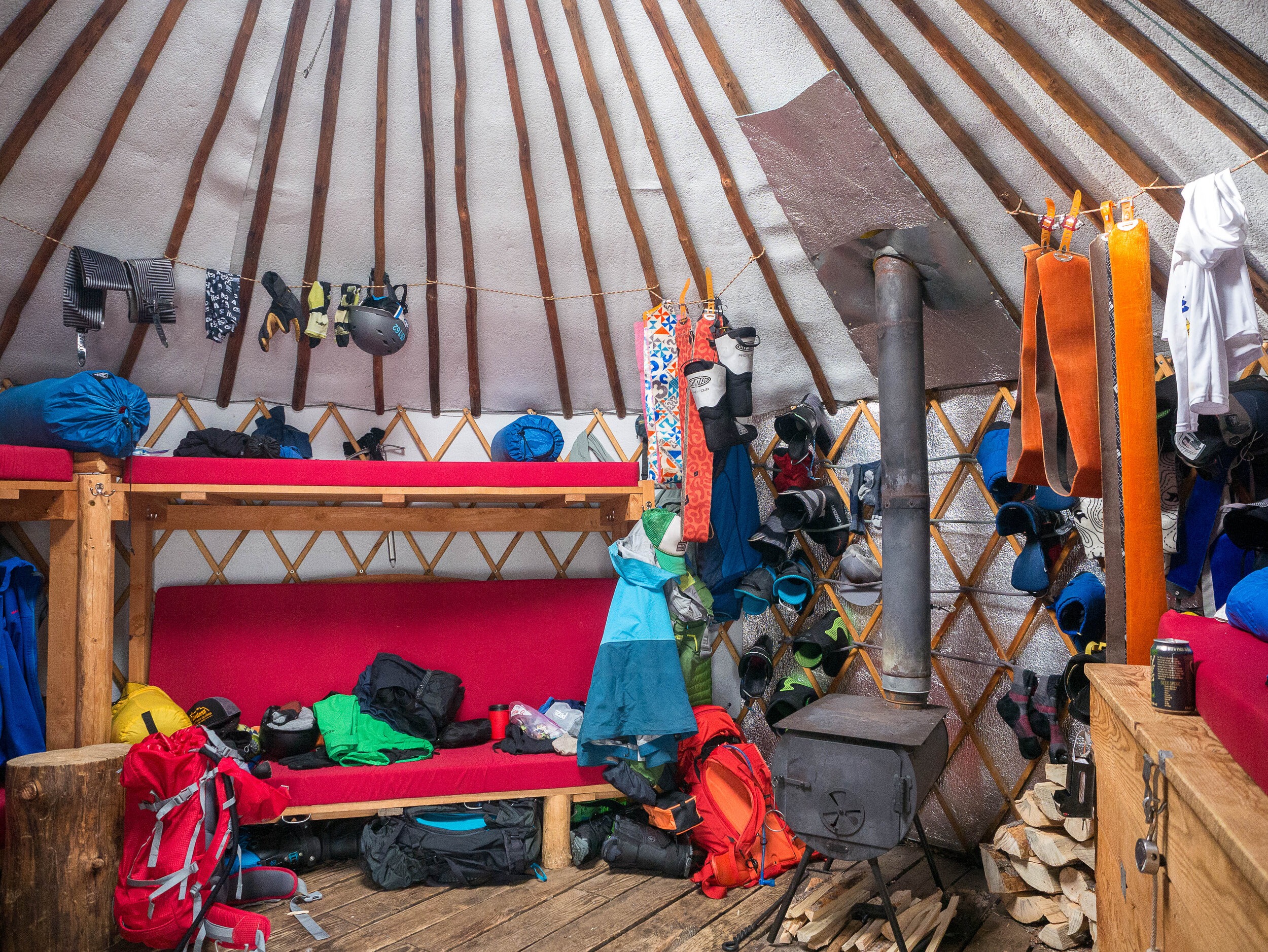
EXPLORE HUTS ↗
Explore a growing catalog of huts in north america, including details such as location, approach stats and more.
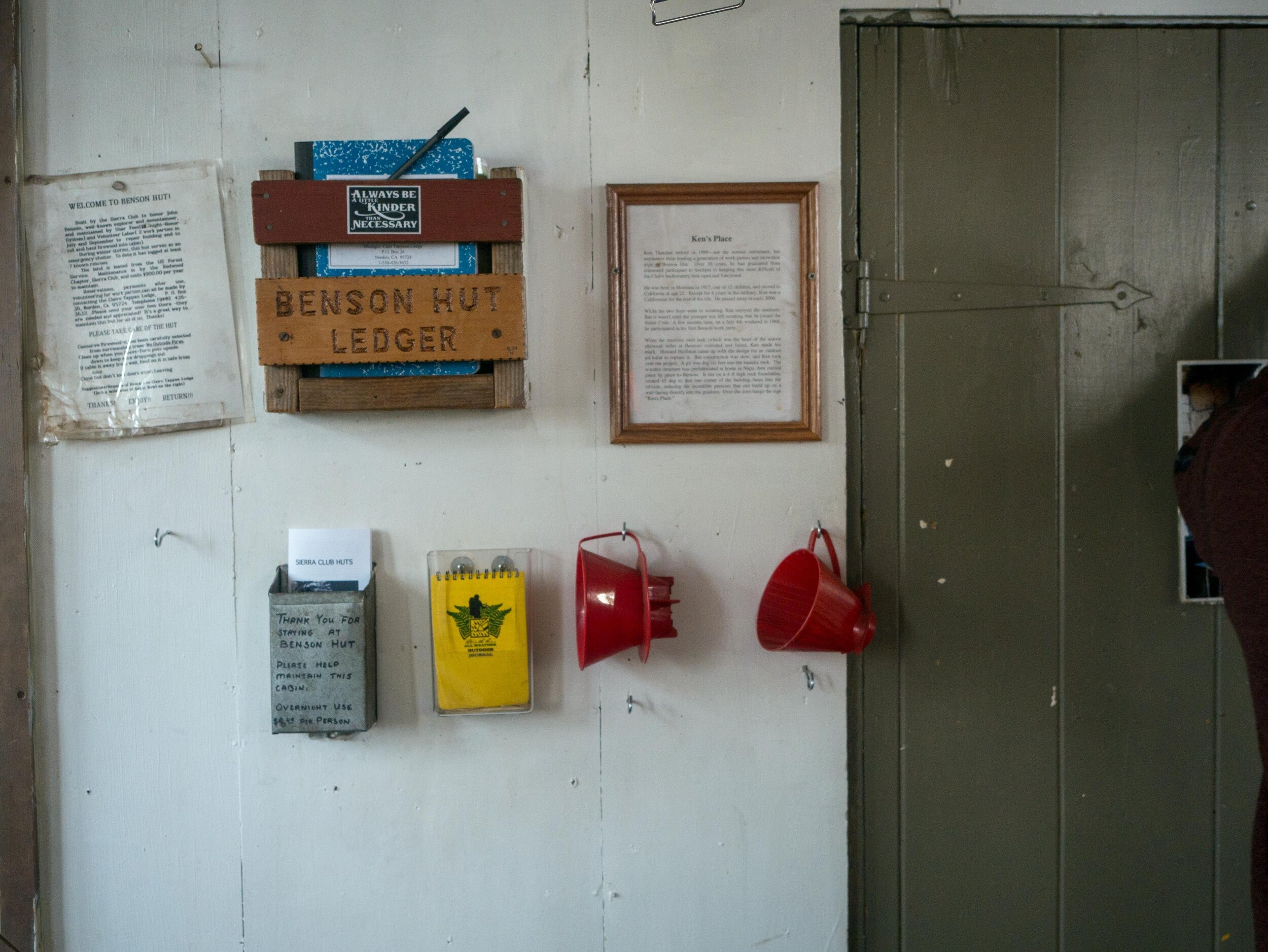
BROWSE ARTICLES ↗
Read through a variety of articles discussing hut-based tours, gear and other opinion pieces.
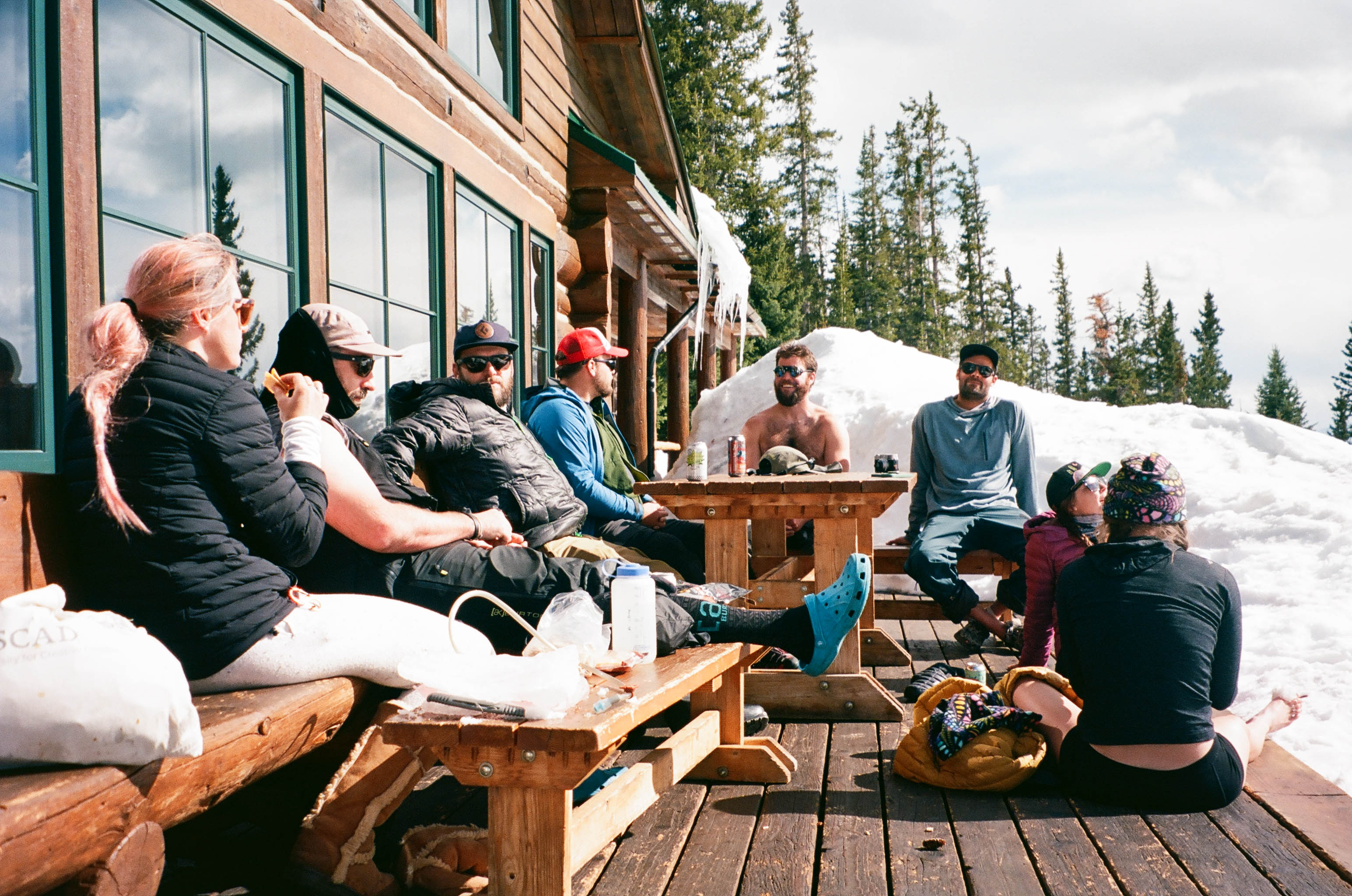
Stay informed with site updates & hut news!
Hut Tripper aims to be the go-to hub for backcountry hut exploration, crowd-sourced beta, and trip planning resources geared toward winter backcountry travelers. We're backcountry enthusiasts, ourselves, combining our love for alpine skiing, the wilderness, and adventure. We exist to empower new & existing backcountry travelers to explore the mountains in a responsible and informed way, consolidating winter backcountry accommodations as far east as the Rockies and detailing each with an ever-evolving list of hut details and beta.

- (970) 949-9111

Backcountry Hut Trips
All ages 12 and up
Experience the unique and unforgettable adventure of a private backcountry hut trip with Apex Mountain School. These hut trips combine warm and comfortable backcountry huts and access to exceptional backcountry skiing and snowboarding. By day, venture out into the San Isabel National Forest for fresh turns in a high alpine environment, with instruction from our expert guides on efficient travel, skiing/riding techniques, and terrain selection to maximize your fun out on the slopes. In the evening, relax by the fire with a hot cup of tea as your guide prepares a hearty, home cooked meal on the woodstove and enjoy uninterrupted views of the untamed Colorado Rockies.
Colorado hut to hut tours continue to grow in popularity; experiencing a backcountry hut tour with our ski guides is a great way to connect with the Colorado landscape while increasing your knowledge of backcountry travel and avalanche preparedness. The huts themselves offer a uniquely luxurious backcountry experience that will leave you refreshed and ready for the next day of skiing/riding. Spectacular terrain bordering hut areas offer extensive options for backcountry skiing and riding for all ability levels.
Hut trips can also be combined with AIARE compliant avalanche curriculum to add formal education to your hut trip. For more information check out our AIARE Level 1 Avalanche Course page.
Anna’s Cabin
Anna’s is a completely off-grid, backcountry hut located on the Continental Divide at an elevation of 11,700 ft. Surrounded by thousands of acres of San Isabel National Forest, there are no other structures for miles, and none in sight, for a very remote feeling retreat that’s only 1.8 miles from the highway and parking area. It’s a great base camp for backcountry adventures on the high Colorado trails. Wildlife sightings are very common. No electricity or running water – bring your own bottled water or melt snow on the woodburning stove. Indoor composting toilet facilities.
Booking / More Info
Backcountry hut trips – quick info.
Get out this season and enjoy our Backcountry Hut Trips.
- March 19-20
2 days/1 night or 3 days/2 nights (call for booking info)
Open Enrollment $360 per person, per day. Cost does not include Hut Rental. Larger groups welcome! Please call 970-949-9111 for pricing and details.
Leadville, CO (Chalk Creek)
Easy – Difficult
See our inclusion policy for special group requests.
WHAT TO BRING
Each person in your party will need.
- An AT (Alpine Touring), Telemark, or Splitboarding package.
- Beacon/probe/shovel (rental available)
- *No cotton – cotton does not wick moisture or insulate when wet.
- Synthetic or wool long underwear bottom (thin)
- Synthetic or wool long sleeve top (medium)
- Mid layer top and bottom
- Synthetic or wool socks
- Winter jacket
- Insulated “Puffy” Jacket
- Warm gloves or mittens
- Hat and neck gaiter or balaclava
- Goggles or sunglasses
- Small day pack
- Water bottle (70-100 oz of liquid for 1.8-mile approach from parking lot)
- Multi-day pack (40-70L)
- Sleeping bag – recommended 0° to 40° for hut, weather dependent
- Space blanket
- Personal hygiene kit – toothbrush/toothpaste, hand towel, comb/brush, prescriptions. Feminine products, if applicable
- Change of clean undergarments, per day
- Headlamp with spare batteries
- Hut slippers or down booties
- Food: See “Food List”
SLEEPING ARRANGEMENTS
- One double “sleigh” bed on main floor
- One queen bed
- Two sets of bunk beds in upstairs loft (ladder climb required)
Please communicate with us when booking about how you would like to proceed with food: If you specify that you would like us to work with a budget set by you, our guides can shop for and cook for you for the cost of the grocery bill. If you’d prefer to handle the food and cooking yourself, you certainly may, or you can use some of our ideas. In the past, lightweight, calorically-dense, low-sodium foods have served as good choices.
- Oatmeal, topped with nuts and dried fruits
- Cheese sticks
- Jerky or dried fruits
- Granola bars
- Tortillas with peanut butter and honey
- Quick rice meals using hot water
- Dehydrated meals (be aware of sodium if it’s a concern)
- Tortillas with cheese
- Pepperoni for stovetop pizzas
- Coffee (pour-over or instant)
- Dried milk for cream.
Some of the items that are popular have been listed above, but please keep in mind that this is simply a list to use as a resource, and not meant to be comprehensive or a reference for necessities.
ALSO CONSIDER
- Hand warmers
- Extra gloves
- Shorts for the deck?
- Word of warning: keep your pack as organized, compact and lightweight as possible. Not only will you be touring uphill on approach with your pack and all of its goods, you’ll be skiing back downhill on the way out with nearly the same weight.
TRIP INCLUDES
- Land and use fees
- Private guide
- Instruction
- Propane gas cook stove
- Kitchen utensils (pots, pans, etc.)
- Oil lamps provided
Hut fees not included.
ALPINE TOURING SKIS
Alpine Touring Skis allow backcountry skiers to ascend uphill with heels free, in walking mode with skins, and shorter boots make for ease of backcountry travel. Transitioning into downhill mode is as simple as removing your ascension skins and locking your heels down. The downhill ski technique is very similar to traditional downhill skiing at a ski area. This set-up, known commonly as AT skiing, offers an excellent opportunity for resort skiers to experience the backcountry.
SPLITBOARDS
Splitboards are snowboards that are halved down the middle. They can be used as ascension skis during uphill travel, accompanied by skins, and rejoined as a single unit for descent. Splitboards offer the resort rider an efficient transition to backcountry riding.
TELEMARK SKIS
follow Me On instagram
Join My Newsletter
Partnerships
Join the Infertile Circle
Sarah Herron
How to Plan a Backcountry Hut Trip
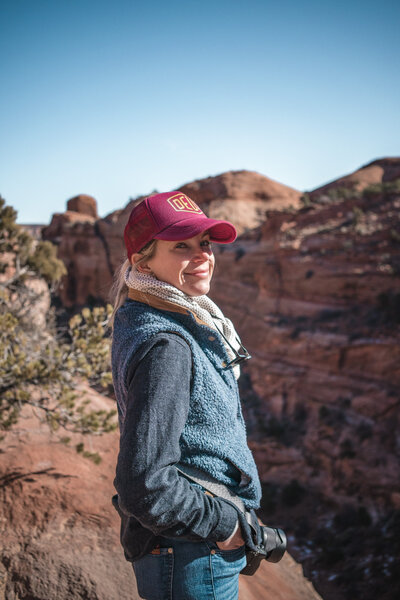
Whether you're looking for ways to hit the road this summer, or are navigating the road to motherhood, new ventures can be overwhelming. I've got you covered with these helpful posts.
Hi, I'm Sarah
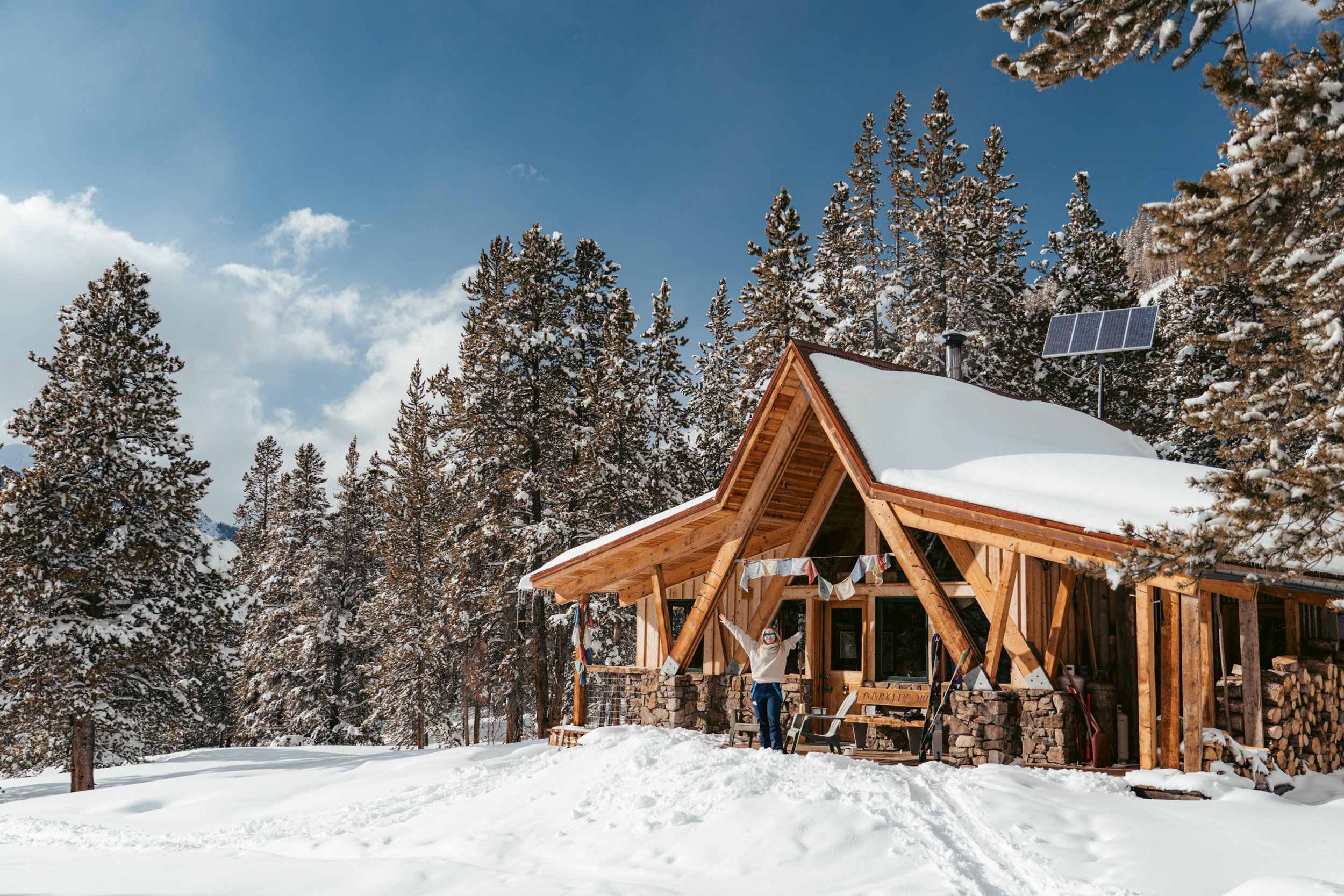
As soon as I learned about ski hut trips, I wanted to go on one. Then I learned how coveted the permits are for the popular hut systems. Often, you need to plan a backcountry hut trip far in advance—even an entire year beforehand—unless you are invited on another group’s trip. So when my friend Taylor put together a trip for our friends, I was beyond excited—but also intimidated.
In this post, I’ll go over everything you need to know to plan a backcountry hut trip from the reservation process, packing list, meal prep and more. Whether you are hosting the adventure, or attending someone else’s trip as a guest for your first time, this information will have you pro-level in no time.
Here’s a 101 on how to plan your first-ever backcountry ski hut trip.
I had been skinning countless times, though never while carrying a 40-pound backpack. I imagined it was like going backpacking but on skis. I was nervous about the sleeping situation. I’m particular about my sleep routine, need quietness, and prefer privacy, so sleeping in a hut without separate bedrooms was beyond my comfort zone. The bunk rooms are often shared with a few others or the entire group. Light sleepers, pack ear plugs!
Here’s out the adventure panned out.

My First Ski Hut Trip
My inaugural ski hut trip was to Markley Hut , which is among the state’s wildly popular 10th Mountain Division Hut Association hut system. The organization owns a dozen huts and maintains the reservations for a total of 30 backcountry shacks speckled throughout the Colorado Rockies, connected by 350 miles of routes in the summer or winter. The name honors the soldiers of the 10th Mountain Division of the U.S. Army. More than 11,000 troops trained during World War II at Camp Hale in central Colorado. Post war, many veterans returned to Colorado and played a key role in the ski industry development.

Magical Markley Hut
Markley Hut is accessed from the historic town of Ashcroft, 13 miles south of Aspen. Our 2.3-mile skin in was a tough push for our 6-person crew. We passed beneath four major avalanche paths, so fortunately the avalanche conditions were stable enough for our trip. One by one, each skiers crossed the avalanche path with at least one bus length between.
Once we caught sight of the hut, the effort was more than worthwhile! Markley was the most magical scene I could dream up: A beautiful, quaint hut nestled in the mountains, packed to the brim with snow, with far-reaching icicles hanging from the eaves.
Inside, I was SHOCKED to see how well maintained the hut was. I was expecting grunge but the interior was cared for meticulously, charming, and well kept. The kitchen was stocked with all of the cutlery, cooking utensils, and cleaning supplies we needed. There were even slippers plus games and books! Despite no electricity or running water, I wasn’t worried, given that’s usually the case while glamping, which I’ve done dozens of times.
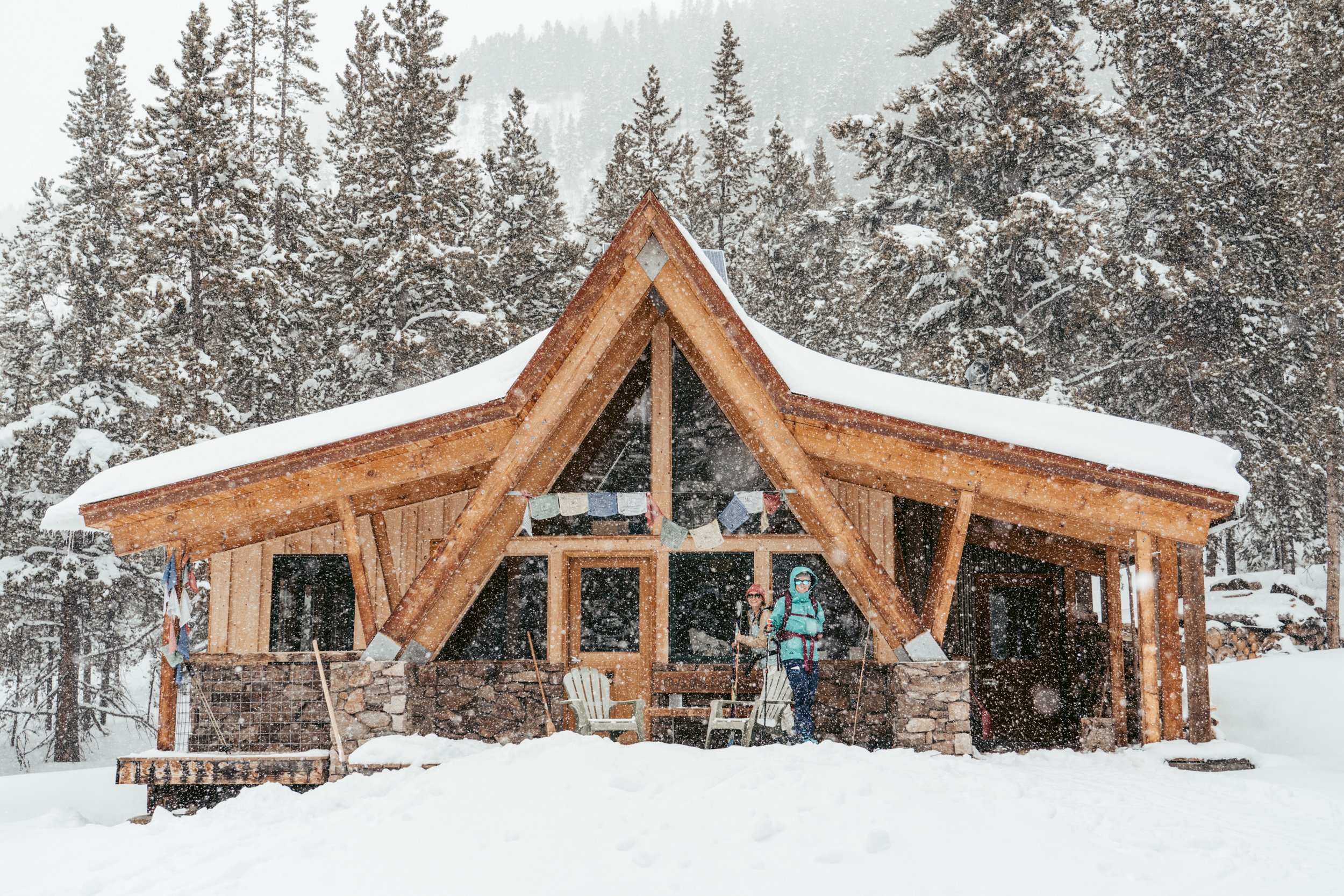
Soon after we arrived, I settled in and lounged on the porch in the sunshine for the afternoon while the rest of the group took another ski tour further up the mountain and enjoyed the untracked snow.
Meal Planning & Chores
We divided up the meal responsibilities, just like when we go camping. Teams of two pre-planned, divvied up the goods in their packs, and prepared their assigned dinner and breakfast. Lunch, snacks, appetizers, deserts, and boos were up to each person to bring along—and share! We also designated hut chores to each person. Someone was in charge of boiling the water while others were in charge of sweeping, washing the dishes, collecting the trash, and so forth.

Like many camping and backpacking trips I’ve been on, our group brought too much food. But that was an OK problem to have. We were excited to indulge, lounge by the heat radiating off the stove and ski all weekend.
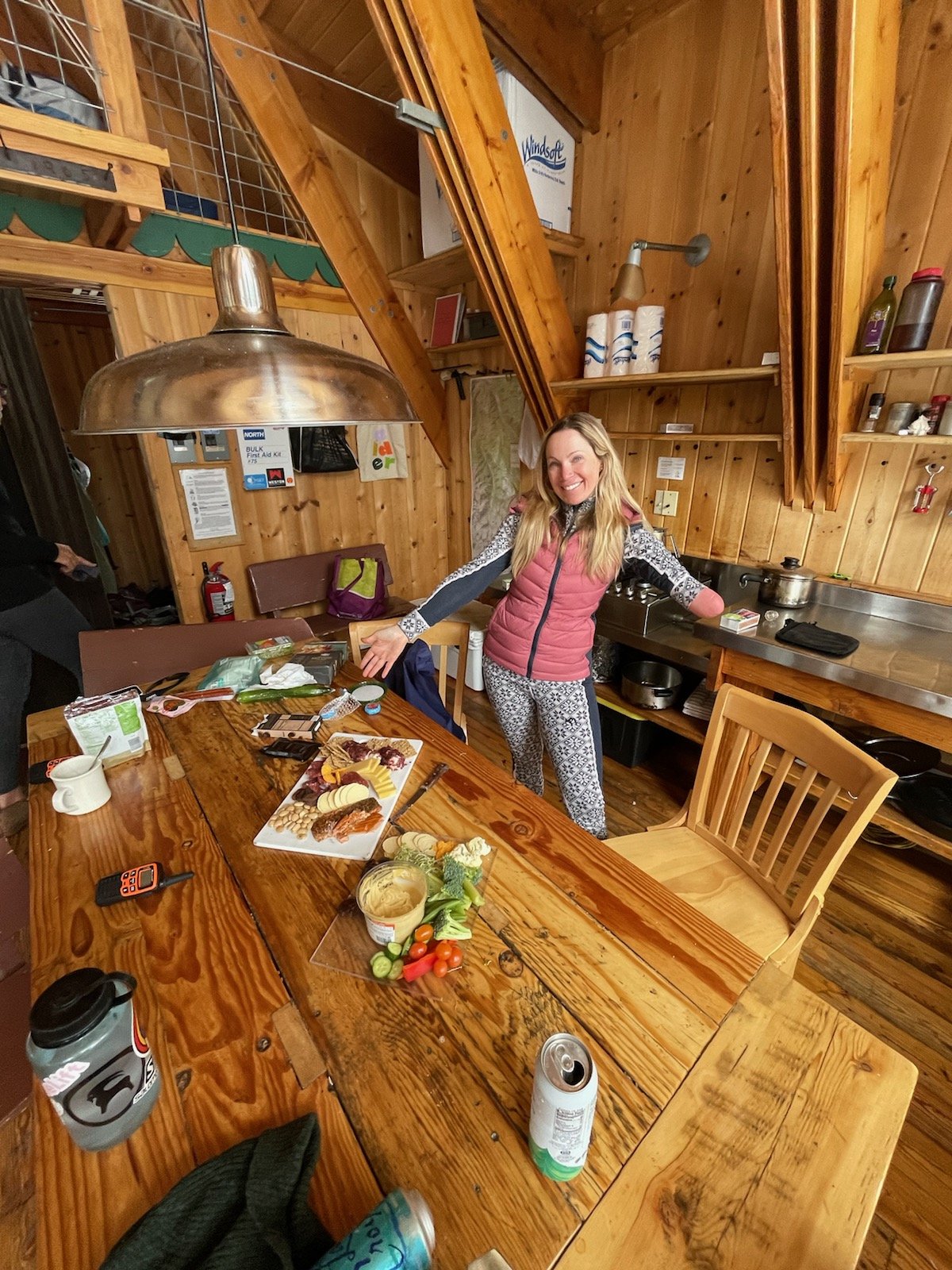
Skiing Around the Hut
After a night’s rest, I was ready to join the group again for a backcountry ski outing. I had never backcountry skied in such a remote area. The experience felt eery, majestic, and our group communication was clear and solid. We saw two guided ski groups but otherwise had the entire region to ourselves.
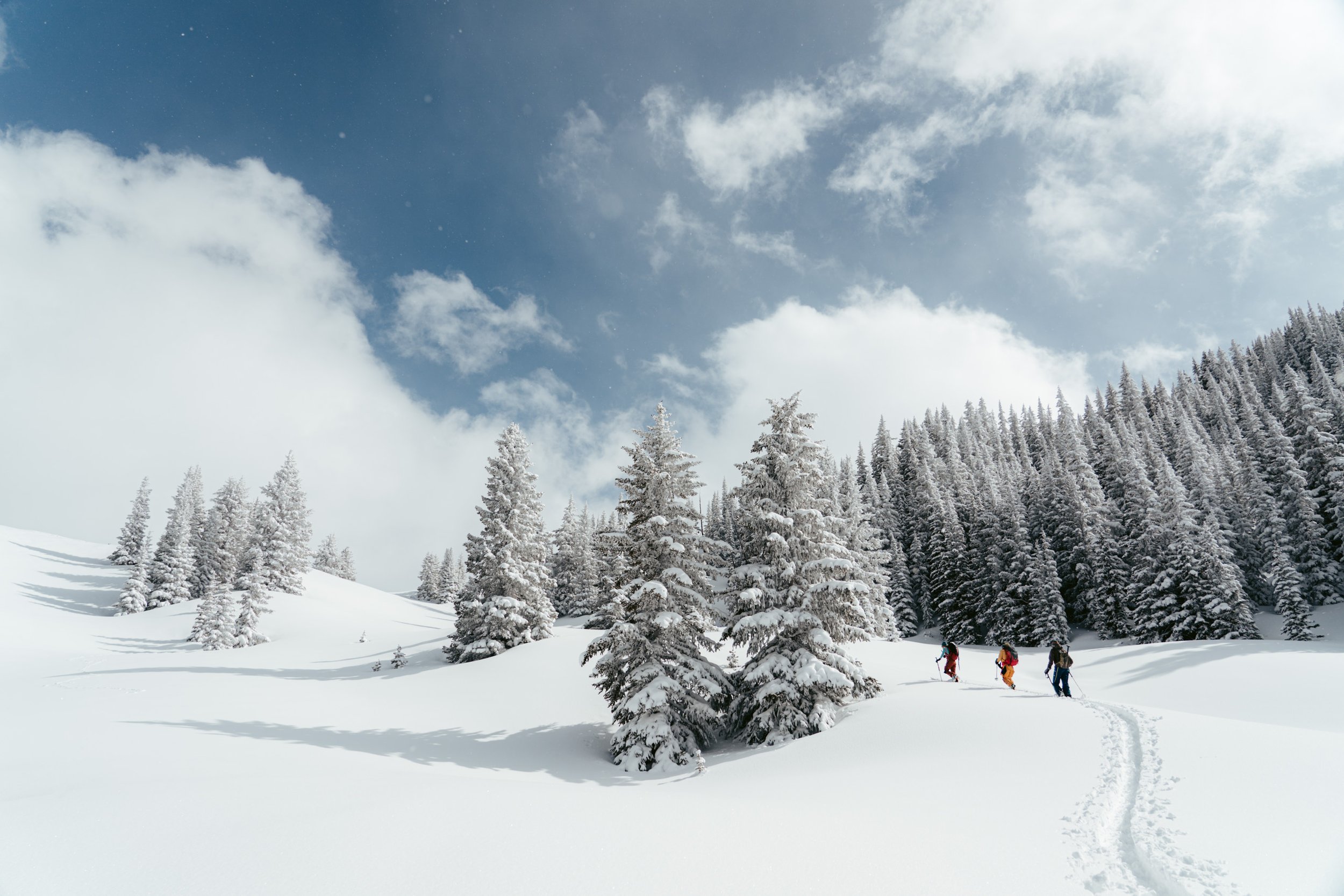
That night, we feasted, played games, and the sleeping situation turned out to be not so bad. (I brought ear plugs!)
Surprisingly, there’s nothing I would do different. I had the best experience on my first ski hut trip. I strongly recommend that visiting groups are well versed in avalanche safety, and trust and feel comfortable with the group of people they go with. I felt very safe with my backcountry ski trip partners.
How to plan a backcountry hut trip: reserving a hut
Still-standing mountain huts have provided shelter to backcountry travelers throughout the United States, all over Europe, and in Canada for decades if not centuries. In our Colorado region, these shacks were established not only for ski mountaineers but also sheep herders and Forest Service guards in the 1940s. These gems of history can still be utilized for outdoor adventure today.
These North American hut systems sit at the top of our trip list:
10th Mountain Division Hut Association , Colorado
Carter Notch Hut , New Hampshire
Mt. Tahoma Hut to Hut Trail System , Washington
Ostrander Ski Hut , California
Glacier Point Ski Hut , California
Peter Grubb Hut , California
Never Summer Nordic yurts and cabins, Colorado
Golden Alpine Holidays , British Columbia, Canada
Sun Valley Mountain Huts , Idaho
Teton Backcountry Guides yurts, Wyoming-Idaho border
When you plan a ski hut trip, one person can book an entire hut, which typically means paying for the whole reservation up front, and then reach out to invite friends. Or, individuals can reserve their personal bunk in a hut based on the current availability. The latter can work for smaller groups but means you’ll most likely be sharing the hut with other travelers.
Pro Tip / Things to Consider:
One tip for uniting the group prior to a trip it to designate a trip organizer , if there isn’t already one person taking the lead. One of the most valuable tools we’ve seen is for a trip leader to distribute a survey asking each person’s goals and concerns, and then using that input to create a FAQ document, which ultimately helps the crew prepare. The most common questions we’ve heard prior to a ski hut trip include.
“ How will we handle the skin up to the hut?” The response can include a designated track on a topo map with slope angle shading for the intended route into the hut.
“ Does everyone have backcountry or avalanche experience?” Answering this question will help jumpstart the conversation of who has previous knowledge and experience. You can include a chart with the options: None, Awareness, Level 1, Level 2, and Professional.
“ How will we decide who skis with who?” This topic is more applicable if there is a group of 20 versus four or six skiers. Establish ground rules for the group such as, ‘no one skis alone’ and ‘a single-veto system reigns for all backcountry decisions.’
“What if the avalanche conditions are bad?” Colorado has particularly notoriously unstable snowpack. We pretty much always need to talk in advance about an alternative plan B, in order to temper expectations and be OK with not skiing at all—which is fine by me! There’s so much serenity, relaxation, and social time to enjoy at a ski hut even if you can’t tour a bunch once there.
“What’s the skiing like around the hut?” Study maps and guidebooks for the area, look at the weather and snow forecast in addition to the avalanche report, and read trip reports to get an idea of the terrain and potential routes that are available from your hut. Create and download tracks for potential routes in your map app in advance. You likely won’t have access to many if any resources, such as WiFi or cell service, once you arrive, especially at remote ski huts.
“What do I need to bring?” Each hut has slightly different amenities with some being more luxurious than others. Check out our pack list below to get an idea.
Packing List for a Ski Hut Trip
While this pack list isn’t comprehensive, it’s a great start point for packing for a ski hut trip:
Avalanche safety gear: Beacon, shovel, probe
Skis or splitboard
Ski or snowboard boots
Ski or splitboard poles
BUFF or face mask
First Aid Kit
Lightweight guidebook for the area (such as Beacon Guidebooks )
Download the area’s map data into your choice backcountry ski application such as GAIA GPS or onX Backcountry
1 set of base layers
1 set of outer layers
1 midlayer jacket
1 down jacket
2 pairs of gloves (light and heavy)
2 pairs of ski socks
2 sports bras
1 loungewear set
Hut shoes (i.e. packable down slippers)
Travel toothbrush and toothpaste
Reading glasses, contact lenses
Meals, snacks, tea packets, libations
Some huts provide bedsheets, pillows, electricity, and saunas while others don’t, so here are some additional items based on where you go:
Bathing suit
Micro towel
Sleeping bag liner
Backpacking pillow (like the Sea to Summit Aeros Premium )
Phone charger (if there’s no electricity, bring an external battery pack and your charger cable)
Be sure to check if your hut has COVID-19 requirements such as face masks, proof of vaccination and boosters, negative tests, or single group bookings.
Reservation Process
Each ski hut has its own reservation system, especially huts that are well maintained with amenities. On the other hand, lesser-known, more primitive huts might not have a reservation system at all. As a general rule of thumb, plan to make a reservation 3 to 6 months or more in advance for popular huts. That way, you can be sure to secure the hut you’d like to travel to and with enough bunks or the entire hut for your group.
The most high-demand hut systems even offer a reservations lottery like the 10th Mountain Division Hut Association. Lottery submissions are due by February 15th, and the lottery is pulled on March 1st. Then, another waive of members can book trips on the first business day of April, followed by non-member bookings on the first business day of June. The most sought dates for booking a hut are on weekends from mid-January through mid-March, so submitting dates outside of that window or a weekday itinerary can greatly increase your chance of landing the hut you want!
Good luck, and I hope you learned how to successfully plan a backcountry hut trip!
This post was co-written by Morgan Tilton , adventure journalist
Leave a Reply Cancel reply
Your email address will not be published. Required fields are marked *
Save my name, email, and website in this browser for the next time I comment.
Keep Reading
Things not to say to someone experiencing infertility or pregnancy loss », « far-infrared biomat review, previous post.
Site Credit: Template by TONIC
Get the Newsletter
Sign up to receive tips, tricks and more.
Work With Me

- Telluride Via Ferrata
- Ouray Via Ferrata
- Via Ferrata Triple Crown
- Telluride & Ouray Trekking
- Everest Base Camp Trek
- Telluride & Ouray Rock Climbing
- Black Canyon Rock Climbing
- Moab Rock Climbing
- Intro to Backcountry Skiing
- Guided Backcountry Skiing
- Sidecountry Skiing
Backcountry Ski Hut Trips
- Alaska Range Ski Camps
- Avalanche Rescue Course
- Level 1 Avalanche Course
- Level 2 Avalanche Course
- Ouray Ice Park
- Half-Day Telluride Ice
- Backcountry Ice
- Best 4 Days in Ouray
- Ice Climbing Courses
- Learn to Lead Ice Course
- Alaska Technical Routes
- Telluride & Ouray Peak Ascents
- San Juan Mountaineering Courses
- 7-Day Alaska Mountaineering
- 12-Day Alaska Mountaineering
- Mount Hunter
- Mount Foraker
- Climb Denali!
- West Buttress
- Cassin Ridge
- Private Denali Expeditions
- Denali Climbing Guide
- Mount Everest
- Mount Vinson
- Cerro Aconcagua
- Carstensz Pyramid
- Kilimanjaro
- Meet Our Guides
- Trip Reports
- Uphill Athlete
- Telluride and Ouray’s Local Mountain Guides
After you’ve booked your backcountry ski hut, book one of our local guides for your trip to get the most out of your time in the San Juan Mountains. Our guides will assist with route finding and help locate the best skiing during your stay. If you haven’t booked your hut yet, take a look at the OPUS Hut, Campfire Ranch Red Mountain Pass (formerly Thelma Hut), or Alta Lakes Observatory , and make a reservation to lock in your dates.
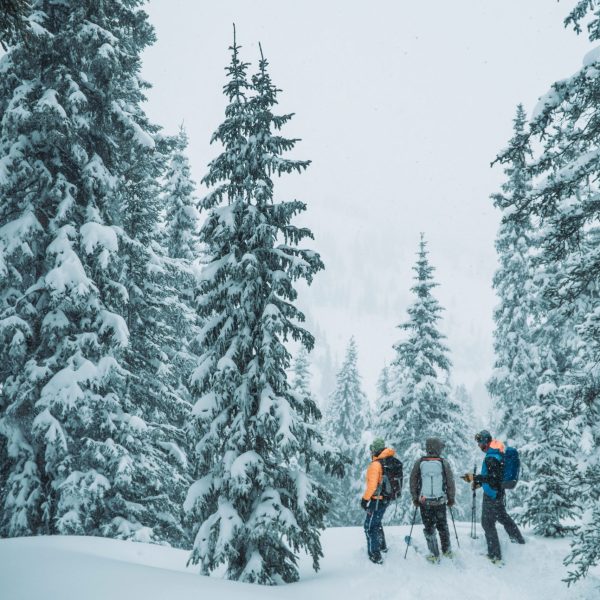
Why hire a guide?
The steep, high-alpine terrain around each hut can be hard to navigate for those new to the San Juans. A ski guide can help you seek out the best snow in the area and objectives that fit your goals and experience. A guide also provides the benefit of route finding to the hut, as the route (specifically OPUS Hut) may not always be clear—especially immediately after a storm, and crosses beneath several major avalanche paths.
To book one of our ski guides, please click below
Book a Ski Guide
Please also account for lodging and meals for your guide, as this is not included when hiring a guide.
If you have questions about traveling to a ski hut or would like help planning your route, please contact the Mountain Trip office at [email protected] or (970) 369-1153.
- What's Included?
- Equipment List
Inclusions and Exclusions for Backcountry Ski Hut Trips
Included in the Trip Fee:
• Guidance of our highly experienced Mountain Trip guides.
• All necessary protective equipment where it is required.
• Assistance arranging post-trip activities in the area.
Not Included in the Trip Fee:
• Travel to and from southwest Colorado.
• Personal clothing and equipment per our equipment list. (Please, just ask us if you need anything!)
• Accommodations in Colorado.
• Travel and/or rescue insurance. (The CORSAR card is an inexpensive way to reimburse local rescue groups for costs incurred during a rescue in Colorado.)
• Costs incurred due to evacuation or unplanned departure from the area due to illness or other problems.
• Costs incurred as a result of delays beyond the control of Mountain Trip.
• Costs as a result of force majeure.
Refunds and Cancellations
Mountain Trip recognizes how difficult and disappointing it can be for guests who must cancel trips. Guests must also recognize that, due to the nature of planning trips and contracting guides for specific dates, Mountain Trip also accrues significant expenses in organizing our excursions. We must therefore adhere to a strict refund policy for all guests.
We require 100% payment at the time of booking and at least 72 hours’ notice for cancellations and rescheduling of activities. If you would like to purchase travel insurance to protect a trip in case of last-minute cancellations, you can do so via Travel Guard HERE .
We are happy to work with you to reschedule to a new date, or if you need to cancel entirely, we will provide a full refund with a minimum of 72 hours’ notice. If you cancel inside of 72 hours ahead of a trip departure, or do not show up, you will not be refunded and will have to reschedule by paying full price.
Please review the cancellation policy for the hut you are booking, as they differ from that of Mountain Trip.
All requests for refunds must be made in writing and received in our Colorado office. No refunds will be provided for cancellations occurring within the last three days prior to the scheduled date of a trip.
Mountain Trip reserves the right to cancel a trip prior to the departure date for any reason. In such an event, all monies collected by Mountain Trip from trip participants shall be promptly refunded. This is the extent of our financial liability.
Weather Cancellations
We, Mountain Trip and our guides, reserve the right to make all weather-related decisions in regards to the cancellation of trips.
The following is a list of guide-recommended gear for Backcountry Skiing with Mountain Trip. In general, you’ll want a selection of warm layers that work together. Clothing designed for a day of resort skiing is fine; however, dedicated touring clothing is better—specifically touring skis or a splitboard, and boots, which differ from a resort setup. Whatever gear you choose, please make sure it fits well so you fully enjoy your experience in the mountains.
All avalanche rescue equipment (avalanche transceiver, probe and shovel) is included with the cost of the trip. Mountain Trip has a fleet of top-of-the-line Black Diamond touring skis, skins and poles, as well as La Sportiva touring boots and Black Diamond airbag skiing packs available for rent.
In addition to what we provide and have available to rent, there is also a good selection of gear available in Telluride and Ouray. If you have any specific questions about what you might need, please don’t hesitate to reach out to the Mountain Trip office.
Rental alpine touring skis, boots, skins and poles are available for $100/day, and airbag packs for $30/day.
Torso Layers
Head and hands, avalanche safety equipment.

Accessibility Tools
- Invert colors
- Dark contrast
- Light contrast
- Low saturation
- High saturation
- Highlight links
- Highlight headings
- Screen reader
- Durango to Moab
- Durango to Paradox
- Telluride to Moab
- Telluride to Gateway
- Gravel Grinder Tour of the Canyons
- Availability
- North Pole Hiking Hut
- Blue Lakes Hiking Hut
- Ridgway Hiking Hut
- Burn Hiking Hut
- Last Dollar Ski Hut
- North Pole Ski Hut
- Blue Lakes Ski Hut
- Ridgway Ski Hut
- Burn Ski Hut
- Spring Creek Ski Hut
- Online Shop
- News & Events
- Travel Resources
- All Hut to Hut Calendars
- San Juan Hut Blog
- Availability Calendars
Warm, dry huts separated by ski and snowshoe adventures. What could be better?
Backcountry ski huts.
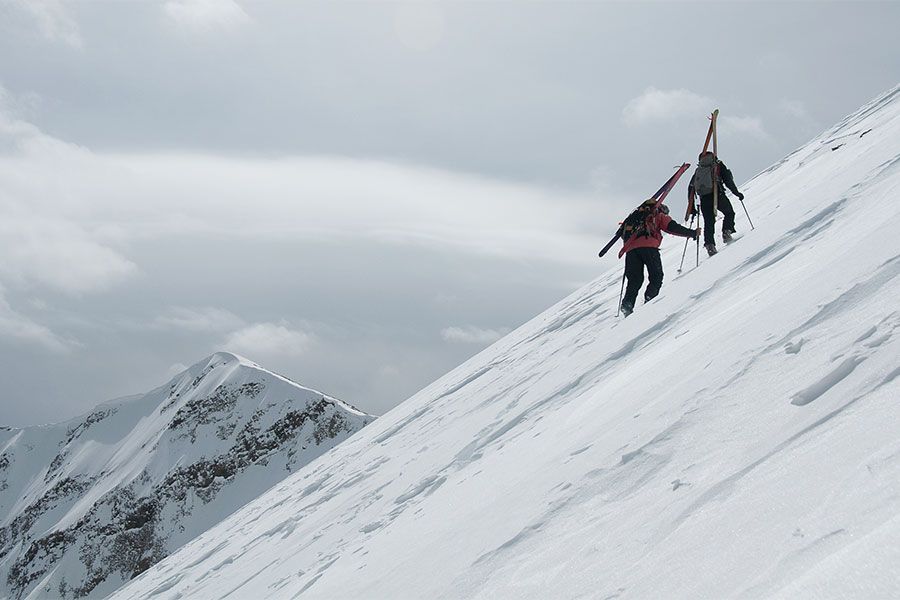
San Juan Hut Systems’ mission is to provide low impact, human powered, lightweight backcountry travel opportunities for the independent health conscious adventurer at a practical price. We have devoted over twenty-five years to creating and defining destination hut-to-hut skiing and mountain bike travel.
The San Juan Hut System Hut-to-Hut backcountry Ski Route links Telluride to Ouray following the Sneffels Range below 14,000 foot alpine peaks. Huts may also be accessed individually. Backcountry ski trails follow scenic United States Forest Service roads and hiking trails surrounding the Mount Sneffels Wilderness Area. The route is designed for intermediate skier ability, while above each hut there is terrain for advanced/intermediate, expert and extreme powder skiing.
Ski Hut Facilities
Huts hold eight people per night. The wooden huts are equipped with padded bunks, a propane cook stove, propane light, wood stove, firewood, and necessary utensils and cookware. Each hut is equipped with a composting toilet facility.
Additional supplies stocked at each hut:
Paper towels, paper plates, toilet paper, cleaning supplies, bleach, dish soap, dish towels, hand sanitizer, lighters, olive oil, hot sauces, salt and pepper, coffee filters, percolators, pour-overs, and fire extinguishers.
- General MTB Info
- San Juan Huts Cuisine
- General Hiking Info
- North Pole Backcountry Hiking Hut
- Blue Lakes Backcountry Hiking Hut
- Ridgway Backcountry Hiking Hut
- Burn Backcountry Hiking Hut
- General Ski Info
- Spring Creek Hut Info
- Getting Here
Skier Ability & Awareness
What people are saying.
We have been using their huts for years. They are consistently fantastic. The locations of the huts are prime! Everyone with SJ huts are always great to work with.
~ Dan Gragert, Omaha, Nebraska
Winter Ski Hut Info
Guide services.
Cirque Guides
(970) 633-2469
Rental Services

What You Get
- Comfortable Huts to Stay in
- Wood stoves and use of firewood pile
- Custom Maps
- Custom GPS Tracks
- Turn by Turn Directions
- Backup Support
- An Adventure of a Lifetime
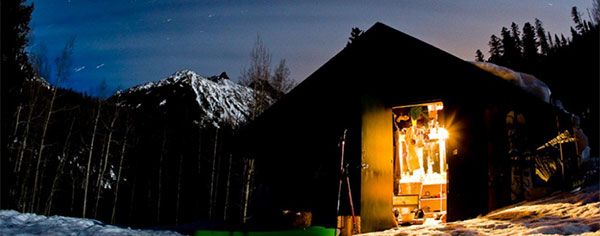
Accommodations
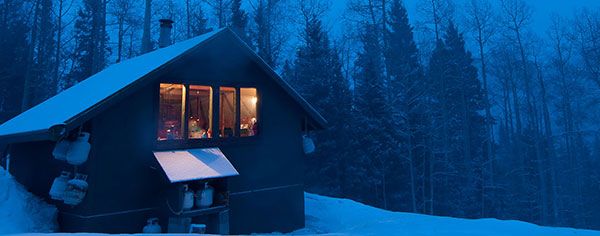
Skiing FAQs
- Who can provide transportation for me?
- Where can I find lodging?
- Where can I rent ski equipment?
- What kind of skis should I use?
- What about avalanche conditions above the huts?
- What are avalanche conditions like between huts?
- What are avalanche conditions like while accessing the huts?
- What are the trails like between the huts?
- How hard is it to get into the huts?

- Gripped Magazine
Three of the Best Canadian Backcountry Hut Ski Tours
The spearhead traverse, wapta traverse and la traversée de charlevoix offer world-class backcountry experiences.
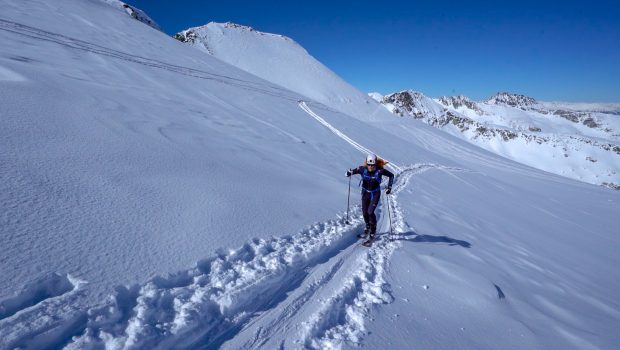
Canada has a lot of backcountry skiing, with world-class glaciers, stunning peaks, challenging terrain and a lot of huts.
If you’re not familiar with a hut trip, they involve multi-day excursions to remote areas and they require more knowledge and gear than a day at the hill. But there’s nothing better than finding untracked slopes, spending time with partners around wood burning stoves, and experiencing all that backcountry Canada has to offer in winter.
So, if you’re planning on heading off-piste and leaving the lifts behind, here are three of Canada’s best hut-to-hut tours.
The Spearhead Traverse
This is one of Canada’s most popular ski traverses. It traverses between Blackcomb and Whistler ski areas, traversing 13 glaciers and nine passes, and is typically done in two to four days. This is not a beginner tour, as it takes you below and over a number of avalanche-prone slopes.
The route is most commonly done in a clockwise loop, starting at Blackcomb Mountain, traversing the Spearhead range then the Fitzsimmons Range and ending at Whistler Mountain.
Buy a backcountry lift ticket from guest services in Whistler Village. It’s cheaper than a regular ticket (around $50) and you don’t have to carry all your stuff 1,600 m up to the top of Blackcomb. From top of Showcase T-bar on Blackcomb, cross Blackcomb Glacier to the Blackcomb-Spearhead col. Climb over Decker mountain. You can go right over the top to the Trorey-Decker col, or drop down a steep slope from the east ridge of Decker to a lower part of the Trorey Glacier. Traverse around the North side of Mt. Trorey on the Trorey Glacier.
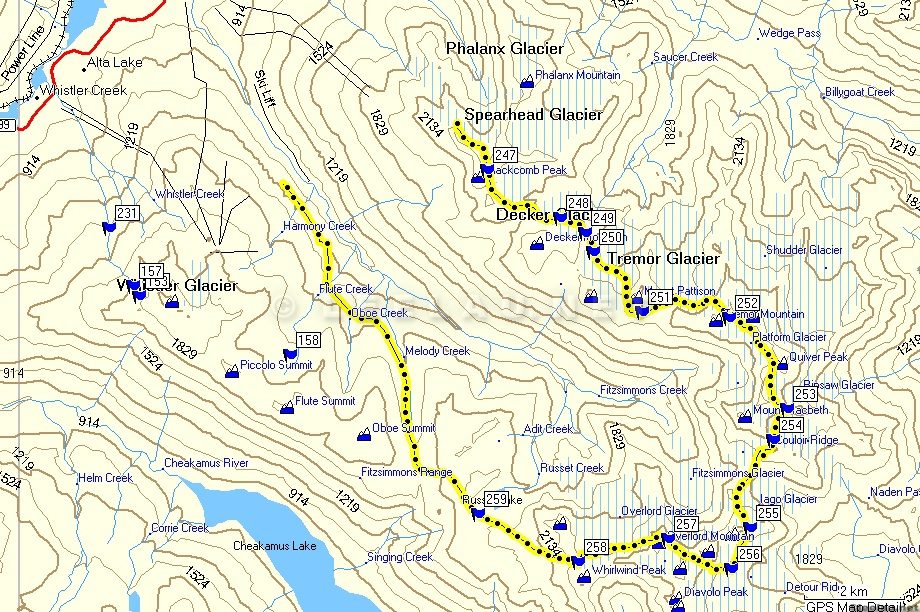
From there, you ski around the south side of Pattison and climb to the col between Tremor and Shudder. Then you traverse the Platform, Ripsaw and Naden Glaciers to the Macbeth Glacier. Follow a ridge off the Macbeth Glacier to the Iago Glacier (steep) and climb the Iago Glacier, and then descend off Iago to the Diavolo Glacier (a steep slope).
Then you climb over Mount Benvolio and then do a spiralling descent around the north side of Overlord, watch for crevasses. Then either descend Overlord Glacier and climb back to Russet Lake, or cross the Fissile-Whirlwind col and descend to Russet Lake. Head West and descend to Singing Pass.
From there, you ski out the singing pass trail to Whistler Village or ski up over the summits of Oboe and Flute to reach the Whistler downhill ski area and descend the ski runs to Whistler Village. Celebrate your amazing achievement at one of the nearby pubs.
The Spearhead Huts project aims to provide an inspiring and accessible hut-to-hut experience on the West Coast. Located at Russet Lake, the Kees and Claire Hut has already been completed. The remaining two locations have been chosen so that travel time is equal between the three, and they are accessible without having to cross a glacier in summer. Each location will offer dramatic views and excellent recreation opportunities year-round.
The Wapta Traverse
The Wapta Traverse is one of North America’s most iconic. The five-day trip will take you to one of the most scenic backcountry ski destinations in Canada. All huts are located high up on the spectacular Wapta and Waputik Icefields along the continental divide. There are a number of premier ski touring summits at each of the hut’s doorstep.
The peaks you can climb along the way rise up to 3,300 meters. You start at Peyto Lake, off the world-famous Icefields Parkway which connects Banff and Jasper National Parks, and will finish on the Trans-Canada Highway just west of Lake Louise.
Since you have to bring your own food and sleeping bag, you should be prepared for a lot of work and bring a big pack. Day one you ski to the Peyto Hut, day two you ski to the Bow Hut, day three you ski to the Balfour Hut, day four you ski to the Scott Duncan Hut and day five you ski out.
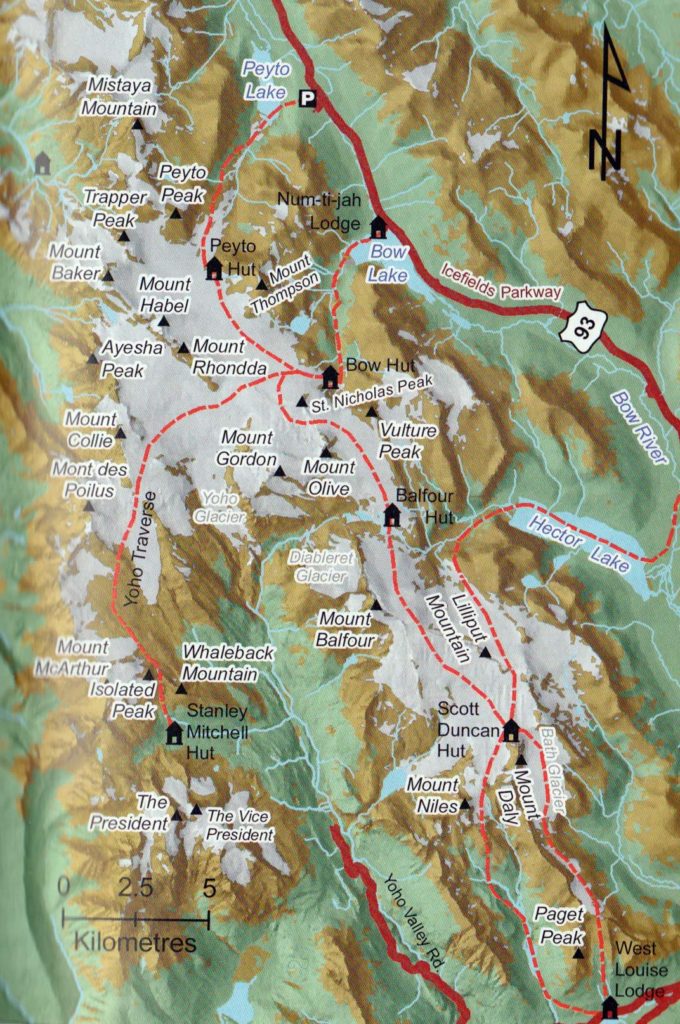
If you don’t have excellent navigation and crevasse-rescue skills, then don’t consider doing the Wapta Traverse. While the skiing is not difficult, you should be comfortable on powder and wind crust.
On May 11, 2014, Peter Knight and Travis Brown took an hour off the record and made the traverse in six hours and 34 minutes. They had great skiing conditions and perfect weather. Brown wrote on his blog , “Overall it was a great day, and snow conditions were almost perfect. As always though, when you finish something big, you always see room for improvement. With the right group and more skintracks in I think it could go in under six hours.”
La Traversée de Charlevoix
This backcountry 105-kilometre trail takes you through the Laurentian Mountains and past the Hautes Gorges, some of the tallest rock walls in eastern Canada. While the forests are stunning, the real treat of this tour is the cozy hut you get to stay in every night.
Built in 1978, the Traversée is the oldest long-distance ski route in Quebec. Most groups take six nights and seven days, stopping at cabins or cottages along the way. To make this even more amazing, the non-profit that runs the lodging will shuttle your gear and food between shelters for you.

The first day is a four-kilometre ski down an old road to a nice cabin. From here, a narrow trail cuts through tall trees and over ups and downs. The second day is considered the most difficult. As you continue along on day three, the skiing gets easier as you catch a glimpse of the St. Lawrence River and the Laurentians from the top of Montagne de la Noyée, an optional detour.
Day four is the longest of the week with 20 km past Rivière Malbaie, and soon a view into the Hautes Gorges, part of the Charlevoix World Biosphere Reserve. Day five and six wind through enjoyable flats and the snowiest sections of the trail.
The first and second day could be combined to cut a day, thanks to the huts being close. There is also an option to do a four-day, three-night trip.
There are long distances of travel through bush and not all of the trail gets cell coverage. So you should be self-sufficient with minor equipment repair. The trail is well-marked, so navigating terrain is easy. The terrain is pretty easy, but skiing for a week straight, sometimes breaking trail, will take a toll.
Check out the latest buyer's guide:

The Best Fall Camping Gear Essentials
- Email address: *
- Comments This field is for validation purposes and should be left unchanged.

From powder glades to open bowls to rock-lined couloirs, we have terrain for everyone.
Sawtooth Mountain Guides specializes in guided backcountry skiing and ski touring for skiers of all abilities - backcountry novices to hardcore steep skiers. Our extensive ski terrain ranges from the easily-accessible powder slopes and chutes of Galena and Banner Summits to the jaw-dropping ruggedness of the Sawtooth Range. Whether on a day trip or based at our comfortable hut, we have something for everyone.
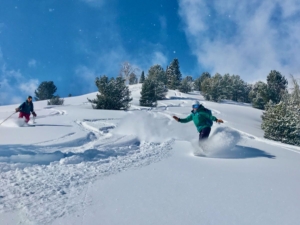
Intro to Backcountry – Sun Valley
Curious what the backcountry buzz is all about? Learn the fundamentals of backcountry skiing and riding with a professional instructor.
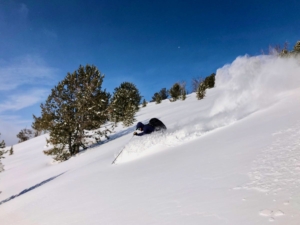
Sun Valley Backcountry Skiing
Easily-accessible backcountry skiing for all abilities a short drive from Sun Valley.
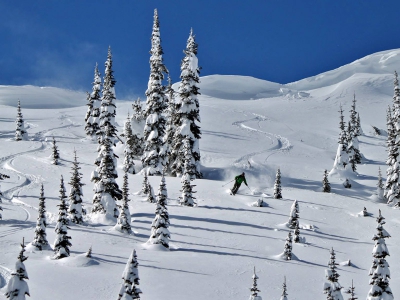
Banner Summit Backcountry Skiing
Banner Summit features some of the most consistent powder conditions in central Idaho.
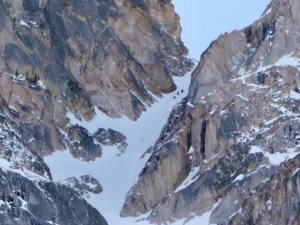
Sawtooth Ski Mountaineering
The Sawtooths are known for their high concentration of couloirs tucked between spires and pinnacles.
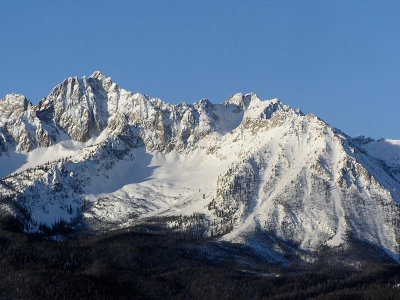
Guided & Catered Hut Trips
Simply put, a fully guided hut trip to the Williams Peak yurts is as good as it gets.
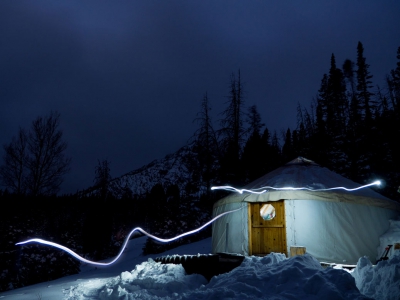
Williams Peak Hut Rental
In the heart of the Sawtooths, the Williams Peak Hut has terrain to satisfy everyone.
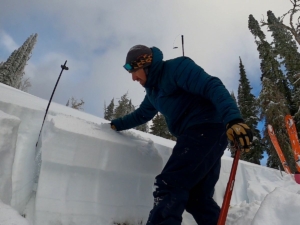
AIARE Level 1 Avalanche Course – Boise
Learn the key elements of making sound decisions while traveling in avalanche terrain.
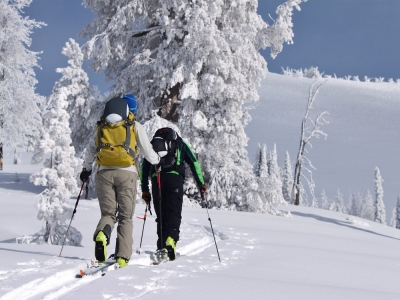
AIARE Level 1 Avalanche Course – Sun Valley
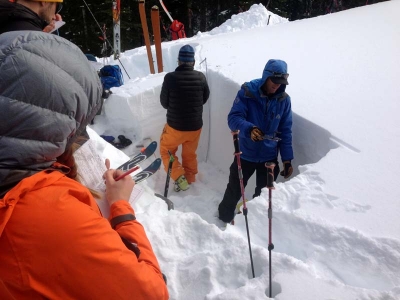
AIARE Level 1 Avalanche Course – Stanley
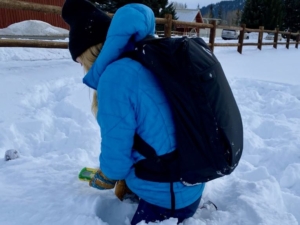
AIARE Avalanche Rescue Course – Stanley/Sun Valley
Learn the fundamentals of avalanche rescue so you can save your partner’s life if the unimaginable happens.
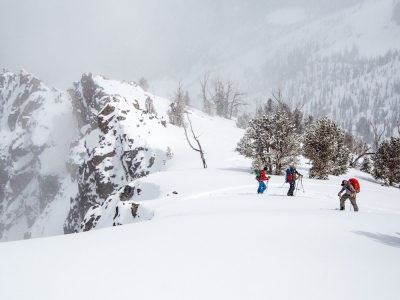
AIARE Level 2 Avalanche Course – Stanley/Sun Valley
For advanced backcountry skiers and riders venturing deeper into the backcountry.
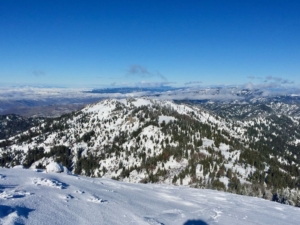
Intro to Backcountry – Boise
Excited to ski the backcountry but don’t know where to begin? This course is for you!
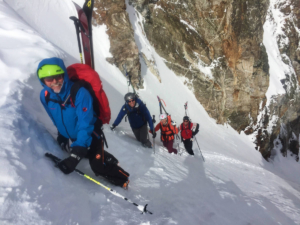
Spring Ski Mountaineering Camp
Spring in the Sawtooths provides the perfect venue to learn ski and snowboard mountaineering techniques.

- Backcountry Skiing
Experience the best of the Crested Butte Backcountry
Join us for a Crested Butte Backcountry Skiing or Splitboarding Trip this winter! Crested Butte has long been known as a ski touring haven. With a seemingly endless amount of backcountry terrain, you can ski and ride here and never hit the same shot twice. From open bowls, steep and secluded tree shots, to big alpine peaks, the Crested Butte backcountry has it all.
Backcountry Tours with Irwin Guides are private and custom to you! We cater to all ability levels, as well as skiing or splitboarding, and offer Intro to Backcountry courses on any chosen date. Our local Crested Butte ski guides and splitboard guides will help you find the best snow and the best terrain for your ability level.
Women's Backcountry 101 Clinic & Mini Film Festival
More information coming soon, crested butte backcountry skiing pricing.
Book Now Intro Class
- Avalanche Safety gear (beacon, shovel, & probe)
- AMGA-trained, local Crested Butte Ski Guide
Photographer Add-on
Let us capture your Crested Butte Backcountry Ski trip so you can focus on your adventure! A photographer is $675 per trip and based on availability. Please let the Irwin Guide’s office know 48hrs before your trip if you would like to add this to your reservation.
Tour Details
Backcountry powder camp, backcountry skiing hut trips, monarch pass backcountry skiing, crested butte backcountry skiing terrain, prerequisites, explore the crested butte backcountry, click book now to get started planning your adventure, you may also like.
- Ice Climbing Skills Course
- Ski Mountaineering Course
Private AIARE Course
(970) 349-5430
- Fly Fishing
- Mountain Biking
- Hiking & Backpacking
- AIARE Level 1 Course
- AIARE Avalanche Rescue
- AIARE Level 2 Course

Irwin Guides acknowledges our position on the traditional territory of the Ute Peoples. We operate under special use permits in the Gunnison National Forest, Gunnison BLM, Black Canyon of the Gunnison National Park and are an equal opportunity service provider and employer.
© 2024 Irwin Guides.
- Backcountry Pow Camp
- Backcountry Skiing Hut Trip
- Snowcat Skiing
- Ski Mountaineering
- Fat Tire Biking
- Snowshoeing
- Cross Country Skiing
- Peak Climbing
- Crested Butte Climbing Club
- Monarch Crest Mountain Biking
- Stand Up Paddling
- AIARE Level 1 Hut-Based (Crested Butte)
- Avalanche Refresher Course
- Wilderness Medicine
- Guides & Staff

How to Make the Most Out of a Backcountry Ski Trip in Idaho
Until a few years ago, I’d spent most of my winters at ski resorts, riding lifts and looking for untracked snow. But that all changed when I discovered the joys of taking a backcountry ski trip in Idaho. I took my first backcountry ski course and Avalanche 1 certification with Sawtooth Mountain Guides in Stanley, and after a weekend full of learning, practicing snow safety and some good powder turns, I was hooked!
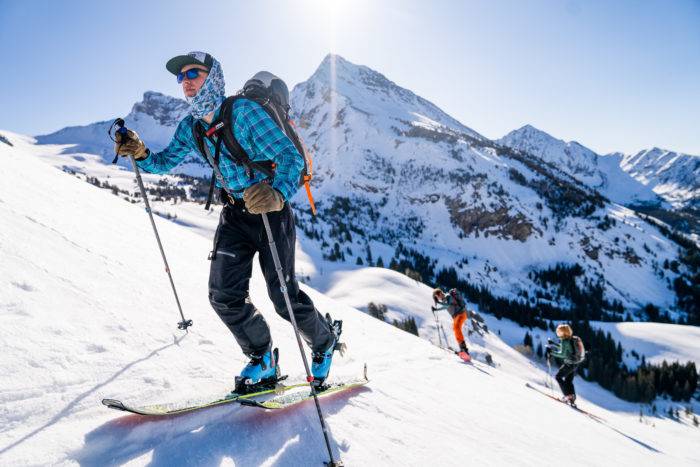
Skiing to Backcountry Yurts
Soon after my preparations, I began going on backcountry ski trips to yurts. Yurts are portable round tents that have a collapsible wooden structure and fabric or canvas coverings. These structures were originally designed by ancient Mongolian tribes, but have been adapted all over the world. There are a variety of yurts in Idaho that offer different levels of ski terrain for everyone.
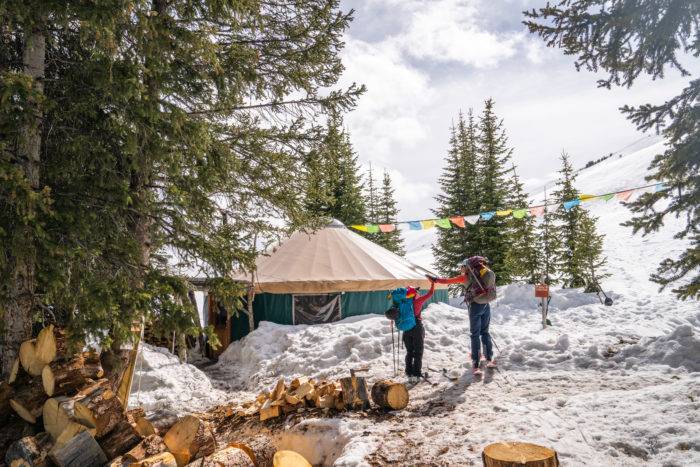
Last year, I visited the Pioneer Yurt outside of Hailey with a group of friends. This yurt sits in a stunning mountain meadow surrounded by large open bowls and steep mountains. It has bunk beds that sleep up to 16 people, a full kitchen, wood and propane stoves, solar-powered lanterns, a library and a wood-fired sauna! These simple accommodations were a perfect welcome after a full day of skiing the high and wild slopes of Idaho’s second-tallest mountain range. Admittedly, it’s a bit rustic, but you will never feel the same sense of achievement or unbridled freedom staying at a resort and skiing inbounds.
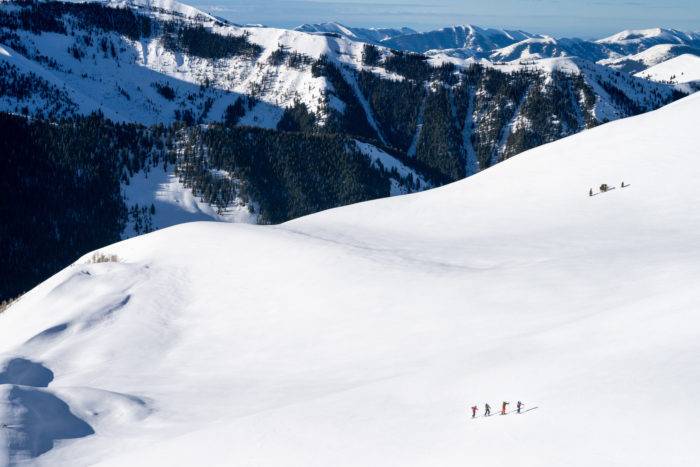
The Overnight Yurt Experience
On the last evening at the Pioneer Yurt, my friends and I cooked a delicious elk taco meal. We played a few games and then started scheming. We wanted to do something special for one of our yurt partners who was a birthday boy. Most yurts don’t have ovens, so we snuck up some shelf-stable Little Debbie’s birthday cakes, threw some candles on them and sang a few raucous rounds of happy birthday. Little efforts like this make yurt experiences unforgettable.
Later we crawled into our sleeping bags, I took a moment to appreciate the magic of the yurt. There we were… dozens of miles away from civilization, in the middle of Idaho, in a cozy yurt surrounded by nothing but snow and mountains. The only sound was the crackling of the fire. Moonlight spilled into the yurt from the window up top and the orange glow of firelight danced across the wood floors. Through the skylight, I could see the stars twinkling in the night and I was thankful to be experiencing this adventure with a close group of friends.
Skiing is just half of the enjoyment you can have on a yurt trip. What makes a yurt trip exceptional is not only good planning but also the people you choose to experience it with. With these tips and tricks in mind, anyone can organize and enjoy a backcountry yurt trip!

How to Book a Backcountry Ski Trip
If you haven’t taken a backcountry trip before, it can be challenging to figure out where to start. There is a lot of logistics and planning that needs to happen. Here’s what you should know to make the most out of any backcountry ski trip.
First, figure out where you’d like to go. If time is limited, Sun Valley Trekking and Sawtooth Mountain Guides have yurts that are accessible with a drive from Boise. There are a variety of backcountry ski cabins, huts and yurts all over Idaho, but here are a few yurts in central Idaho I recommend.
Sun Valley Trekking has about six winter huts and yurts, each offering different terrain. The Boulder Yurt is suitable for skiers with less backcountry experience as it is located just off the highway and is only a 1.5-mile ski to get there. The Pioneer Yurt is one of my favorites in Idaho and is best for more advanced backcountry skiers. It offers a little bit of everything from low-angle glades to steep chutes. The approach is strenuous, roughly six miles, and better suited for people who are in excellent physical condition and who have backcountry experience.
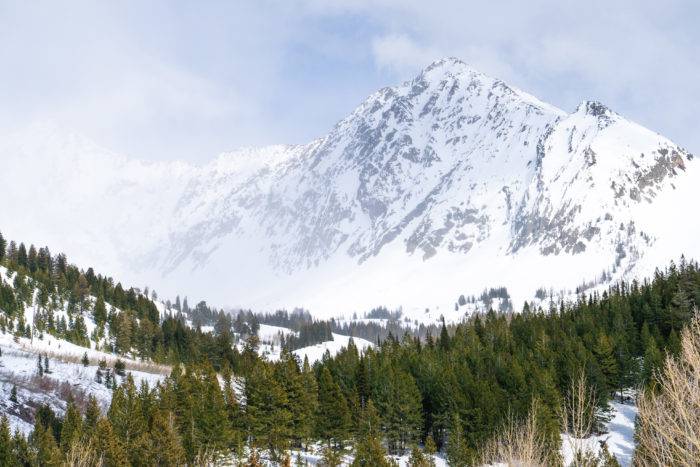
Sawtooth Mountain Guides offers one of the most popular yurts in Idaho called the Williams Peak Yurt. The guiding service recommends intermediate to advanced downhill ski ability to enjoy the variety of terrain around the yurt. The approach is a 5-mile ski-in with 1,600 feet of elevation gain.
Tips for Planning Your Backcountry Ski Trip
For beginner backcountry skiers, I suggest booking a guide on your trip. If no one in your group has been to the yurt, most companies require that you hire a guide. Guides will show you around and help keep you safe in unfamiliar terrain. While an Avalanche 1 certification is not always required to go on these trips, I highly recommend taking a course as it is the best way to keep yourself and others in your party safe.

Before heading out on the yurt trip, do some research on what areas to ski. Sometimes you can find information online by searching your yurt location or you can call the guiding company to get more information. Most yurts have a route book at the yurt. These are super helpful for planning ski routes once you get there. You can take pictures of the maps in the route books, but it’s also helpful to download a navigation app like Gaia before you leave cell service.
Backcountry skiing has become increasingly popular over recent years, and more people are going on yurt trips. If you want to go on one of these trips, it’s essential to book in advance. Depending on which company you are going with, you should check availability on their website six months to a year in advance. Yurts cost about $400 per night. The maximum amount of people allowed at each yurt varies, but if you split the cost with others, it can become more affordable.
What to Bring on a Backcountry Ski Trip
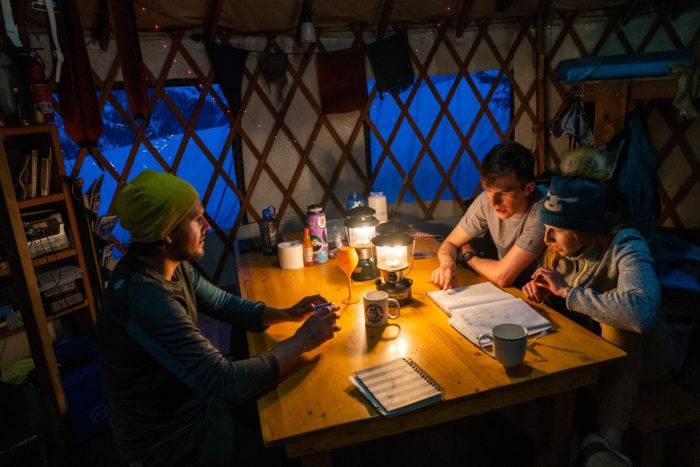
Being prepared for a backcountry ski trip can make or break your first experience. Yurts usually have standard amenities like kitchens, dishes, utensils, beds, bathroom options, lights and stoves, and companies typically provide a list of recommended equipment to bring.
Check the guiding company’s website and make sure you have everything you need on their list, but also, don’t forget to customize your list. Trips are more fun if you bring along items you can share and make you feel comfortable.
Final Thoughts
Lastly, here are a few ideas and personal items to make your trip even better:
- Extra shoes are nice to have so you can put on dry footwear after skiing all day. I like to bring a pair of slippers, tennis shoes or down booties.
- If you are new to backcountry skiing it can take some time to break in your boots. Bring some blister tape or bandages for yourself and others. The last thing you want is to end up with a bunch of blisters and no way to take care of them.
- If you are musically talented, bringing an instrument can liven up the mood and music can be a fun post-ski activity.
- Bring your favorite type of tea! A soothing tea will quickly warm you up after a cold day of skiing.
- Break your group into pairs and have each couple or pair be in charge of one meal. This is fun because you get some variety in cooking and it’s always easy to impress friends with delicious food after skiing.
- If you are going on a yurt trip with people you don’t know and want to make friends quickly, bring some chocolate! Most people love a little nibble of chocolate during or after skiing.
- Games! There are plenty of small packable games that don’t add too much extra weight to your pack but add a lot of fun after skiing. Farkle is one of my favorite games to bring as it’s light and easy to play.
Feature image credited to Sofia Jaramillo.
Sofia is an outdoor adventure and documentary photographer based in Jackson, Wyoming. A few of her clients include National Geographic, The North Face, and Outside Magazine. To see more of her work go to www.sofiajaramillophoto.com or follow her on Instagram .
Updated on August 25, 2023 Published on February 6, 2020

IMAGES
VIDEO
COMMENTS
Hut Trips. View All Winter. Experience the classic 10th Mountain or Braun Huts located from Aspen to Vail with Aspen Expeditions. Unplug from the rest of the world and connect with family or friends in the beautiful Colorado backcountry. Enjoy day guided ski tours and at night relax in the warm hut with gourmet food.
Connecting Anchorage to Girdwood, the 38-mile Eklutna Traverse is Alaska's premiere hut-to-hut route, usually done over five or six days. Shelters along the way include Pichler's Perch, Rosie's Roost and Hans's Hut, each built in the '60s and managed by the Mountaineering Club of Alaska. The route primarily covers low-angle glaciers ...
Welcome to the 10th Mountain Division Huts. 10th Mountain is a 501 (c)3 not-for-profit organization that manages a system of 38 backcountry huts in the Colorado Rocky Mountains, connected by 350 miles of suggested routes. We provide a unique opportunity for backcountry skiing, mountain biking, or hiking while staying in secure, comfortable shelter.
Routes between each average 6 to 7 miles and from 9,700 to 11,700 feet in elevation, making them ideal for high-country skiing and snowshoeing. Edwards -based Paragon Guides also offers custom guided expeditions along this network. Most of the huts sleep 16 people, but the size ranges from capacities of three to 20.
With your hut confirmation in-hand, it's time to start planning your route with onX Backcountry. Use the search bar to easily find the hut you've reserved to start your e-scouting. Investigate the route to your destination, evaluate slope angle, mark avalanche zones with Waypoints, and denote other considerations for your journey.
In addition to safety items everyone should have the same basic gear essentials you would take out on a day tour including: Skis, boots, poles, skins. Goggles + sunglasses. Sunscreen. Plenty of water. Day snacks. Two pairs of gloves (one pair of liner gloves and one waterproof) Wax - for your skins and/or bases. Helmet.
Ski the classic Elk Mountains Traverse from Aspen to Crested Butte, spending the night at two different huts along the way, and exploring all of the ski terrain that they have to offer. Or choose a 1-3 night trip here in Crested Butte's backyard ski terrain. Either way, Irwin Guides backcountry hut trips are private and custom to you.
Hut Tripper is the go-to hub for backcountry hut exploration & trip planning. Find winter backcountry ski huts, yurts, and cabins across California, Colorado, Idaho, Montana, New Mexico, Oregon, Utah, Washington, and Wyoming. ... We're backcountry enthusiasts, ourselves, combining our love for alpine skiing, the wilderness, and adventure. ...
These hut trips combine warm and comfortable backcountry huts and access to exceptional backcountry skiing and snowboarding. By day, venture out into the San Isabel National Forest for fresh turns in a high alpine environment, with instruction from our expert guides on efficient travel, skiing/riding techniques, and terrain selection to ...
My First Ski Hut Trip. My inaugural ski hut trip was to Markley Hut, which is among the state's wildly popular 10th Mountain Division Hut Association hut system.The organization owns a dozen huts and maintains the reservations for a total of 30 backcountry shacks speckled throughout the Colorado Rockies, connected by 350 miles of routes in the summer or winter.
To book one of our ski guides, please click below. Book a Ski Guide. Please also account for lodging and meals for your guide, as this is not included when hiring a guide. If you have questions about traveling to a ski hut or would like help planning your route, please contact the Mountain Trip office at [email protected] or (970) 369-1153.
We have devoted over twenty-five years to creating and defining destination hut-to-hut skiing and mountain bike travel. The San Juan Hut System Hut-to-Hut backcountry Ski Route links Telluride to Ouray following the Sneffels Range below 14,000 foot alpine peaks. Huts may also be accessed individually. Backcountry ski trails follow scenic United ...
The Spearhead Traverse, Wapta Traverse and La Traversée de Charlevoix offer world-class backcountry experiences. Gripped December 3, 2021. Canada has a lot of backcountry skiing, with world-class glaciers, stunning peaks, challenging terrain and a lot of huts. If you're not familiar with a hut trip, they involve multi-day excursions to ...
Backcountry Skiing Hut Trip. Price: Duration: 3-5 Days. Custom dates available for 2022-23. Call our office for reservations: 720-387-8944. We have hut and yurt trips planned for beginner backcountry skiers all the way to itineraries for seasoned vets looking to ski a 14er.
A solid base layer constructed of wool is ideal for any hut trip. It allows you to pack less and not stink (too much at least). The Heist Merino Hoodie is perfect for cold days (the final two days at Sol Mountain Lodge were in the low single digits). The hoodie is warm, has a small pocket and wicks well for quick jaunts.
Entertainment. StreamingVideo GamesCountry MusicTop 100 Music. Food & Drink. WhiskeyBeerRecipesCocktails & SpiritsHealthy FoodWine. There are no do-overs for a multi-day ski trip. These essentials ...
The hut is nearly identical to the Happy Valley Hut but the terrain offers expansive views and the surrounding forest is predominately lodgepole pine. Day 3: Lone Wolf Hut to Three Creeks Sno-Park. On the final day skiers will enjoy a six mile ski that gradually descends more than a thousand feet through the Three Creeks Nordic trail system.
Hut Clothes and Gear. Street pants - 1x - One pair of pants is all you need. T-shirt - 2x - A couple of soft cotton tees for après ski lounging. Hoodie or flannel - 1x - One warmer layer for the hut. Socks - 1x - One pair of socks for wearing in the hut. Hut shoes - 1x - Many huts offer Crocs or similar hut shoes for use at ...
Seven years ago I transitioned from piste skiing to backcountry touring, and dove into the deep end with six hut trips, in Colorado, California, Montana, and BC.
From powder glades to open bowls to rock-lined couloirs, we have terrain for everyone. Sawtooth Mountain Guides specializes in guided backcountry skiing and ski touring for skiers of all abilities - backcountry novices to hardcore steep skiers. Our extensive ski terrain ranges from the easily-accessible powder slopes and chutes of Galena and ...
Monarch Pass Backcountry Skiing. Topping out at 11,312 feet, and located between Salida and Gunnison, Monarch Pass receives over 350 inches of snow in the winter months; while this kind of snowfall is less than ideal for driving conditions, it makes for perfect backcountry skiing and riding. Inquire about pricing.
Hut and Yurt Rental/Guided Trips/Avalanche Training At least four months before the start of winter, reserve the Bench Hut or any of five other backcountry yurts in the area with Sun Valley Trekking, (208) 788-1966, svtrek.com.
Here's what you should know to make the most out of any backcountry ski trip. First, figure out where you'd like to go. If time is limited, Sun Valley Trekking and Sawtooth Mountain Guides have yurts that are accessible with a drive from Boise. There are a variety of backcountry ski cabins, huts and yurts all over Idaho, but here are a few ...